{"/api/v1/ncpl/currencies/getAll":{"body":[{"Name":"U.S. Dollar","Code":"USD","Symbol":"$","Separator":".","Culture":"en-US"},{"Name":"Euro","Code":"EUR","Symbol":"€","Separator":",","Culture":"en-US"},{"Name":"British Pound","Code":"GBP","Symbol":"£","Separator":".","Culture":"en-US"},{"Name":"Canadian Dollars","Code":"CAD","Symbol":"C$","Separator":".","Culture":"en-US"},{"Name":"Australian Dollars","Code":"AUD","Symbol":"A$","Separator":".","Culture":"en-US"},{"Name":"Indian Rupees","Code":"INR","Symbol":"Rs","Separator":".","Culture":"en-US"},{"Name":"China Yuan RMB","Code":"CNY","Symbol":"¥","Separator":".","Culture":"en-US"}],"status":200,"statusText":"OK"},"/api/v1/ncpl/cart/user/getShoppingCartSummary:\"{\\\"finalTotalOnly\\\":true}\"":{"body":null,"status":200,"statusText":"OK"},"/api/v1/ncpl/usermanagement/uiuser/getHeaderUserInfo:\"{\\\"hideSupportPin\\\":true}\"":{"body":{"__ctxId":"324EDE6D7CFB42939CECD94AB3EC8935","__isError":true,"__errorType":"Nc.Platform.Abstractions.UnauthorizedException","Http_WWW_Authenticate":"Bearer","StatusCode":"Unauthorized","LogLevel":3,"Message":"","InnerException":null,"HelpLink":null,"Source":"Nc.Security.Middleware"},"status":401,"statusText":"Unauthorized"}}{"/api/v1/ncpl/simplekb/getarticle:\"{\\\"articleId\\\":9854,\\\"categoryId\\\":2290}\"":{"body":{"Id":9854,"FriendlyId":"","ArticleTypeId":0,"Title":"How to generate a CSR code on a Windows-based server without IIS Manager","ArticleName":"How to generate a CSR code on a Windows-based server without IIS Manager","ArticleSummary":null,"PreponedSummary":false,"Approved":true,"Body":"DQoJCTxwPldoYXQgaWYgd2UgbmVlZCB0byBpbnN0YWxsIGFuIFNTTCBjZXJ0aWZpY2F0ZSBmb3IgdGhlIHNlcnZpY2Ugb3RoZXIgdGhhbiBJSVMgYW5kIHRoZXJlIGlzIG5vIElJUyBNYW5hZ2VyIGluc3RhbGxlZCBvbiB0aGUgV2luZG93cyBzZXJ2ZXI/IEhvdyBvbmUgY2FuIGdlbmVyYXRlIGEgQ1NSIGNvZGUgaW4gdGhpcyBzaXR1YXRpb24/PC9wPg0KCQk8cD5MdWNraWx5LCB0aGVyZSBhcmUgYSBmZXcgd29ya2Fyb3VuZHMgYXZhaWxhYmxlLjwvcD4NCgkJPHVsPg0KCQkJCTxsaT4NCgkJCQkJCTxhIGhyZWY9IiNtbWMiPk1NQyAoTWljcm9zb2Z0IE1hbmFnZW1lbnQgQ29uc29sZSk8L2E+DQoJCQkJPC9saT4NCgkJCQk8bGk+DQoJCQkJCQk8YSBocmVmPSIjY3J0cnEiPkNTUiBnZW5lcmF0aW9uIHVzaW5nIHRoZSBDZXJ0cmVxIHV0aWxpdHk8L2E+DQoJCQkJPC9saT4NCgkJCQk8bGk+DQoJCQkJCQk8YSBocmVmPSIjcHdyc2giPkNTUiBnZW5lcmF0aW9uIHRocm91Z2ggUG93ZXJzaGVsbDwvYT4NCgkJCQk8L2xpPg0KCQk8L3VsPg0KCQk8cD5CZXNpZGVzIHRoZSBmYWN0IHRoYXQgdGhlc2Ugd29ya2Fyb3VuZHMgd2lsbCBub3QgcHJvdmlkZSBhIHdpemFyZG91cyB1c2VyLWZyaWVuZGx5IGludGVyZmFjZSBhbmQgcmVxdWlyZSBhIGJpdCBvZiBmYW1pbGlhcml0eSB3aXRoIHRoZSBzeXN0ZW0gbWFuYWdlbWVudCB0b29scywgeWV0IHRoZXkgcmVtYWluIHZlcnkgcG93ZXJmdWwgZm9yIGFjY29tcGxpc2hpbmcgb3VyIGdvYWwg4oCTIGNyZWF0aW5nIGEgQ1NSIGNvZGUsIHdoaWNoIHdlIGNhbiBzdWJtaXQgdG8gdGhlIENlcnRpZmljYXRlIEF1dGhvcml0eSBkdXJpbmcgdGhlIGNlcnRpZmljYXRlIDxhIGhyZWY9Imh0dHBzOi8vd3d3Lm5hbWVjaGVhcC5jb20vc3VwcG9ydC9rbm93bGVkZ2ViYXNlL2FydGljbGUuYXNweC83OTQvNjcvaG93LWRvLWktYWN0aXZhdGUtYW4tc3NsLWNlcnRpZmljYXRlIiB0YXJnZXQ9Il9ibGFuayI+YWN0aXZhdGlvbjwvYT4uPC9wPg0KCQk8cD5TbyBsZXTigJlzIGxvb2sgYXQgZWFjaCBvZiB0aGUgbWV0aG9kcyBjbG9zZXIuPC9wPg0KCQk8aDQgaWQ9Im1tYyI+Q1NSIGdlbmVyYXRpb24gaW4gTU1DIChNaWNyb3NvZnQgTWFuYWdlbWVudCBDb25zb2xlKTwvaDQ+DQoJCTxwPk9wZW4gdGhlIDxiPkNlcnRpZmljYXRlczwvYj4gc25hcC1pbiBpbiBNTUMgYnkgZm9sbG93aW5nIHRoZXNlIHN0ZXBzOiA8Yj5XaW4rUjwvYj4gJmd0OyZndDsgPGI+PGk+bW1jLmV4ZTwvaT48L2I+ICZndDsmZ3Q7IDxiPk9LPC9iPiAmZ3Q7Jmd0OyA8Yj5GaWxlIDwvYj4mZ3Q7Jmd0OyA8Yj5BZGQvUmVtb3ZlIFNuYXAtaW48L2I+ICZndDsmZ3Q7IDxiPkNlcnRpZmljYXRlcyA8L2I+Jmd0OyZndDsgPGI+QWRkIDwvYj4mZ3Q7Jmd0OyA8Yj5Db21wdXRlciBhY2NvdW50PC9iPiAmZ3Q7Jmd0OyA8Yj5OZXh0IDwvYj4mZ3Q7Jmd0OzxiPiBMb2NhbCBjb21wdXRlcjwvYj4gJmd0OyZndDsgPGI+RmluaXNoIDwvYj4mZ3Q7Jmd0OyA8Yj5PSzwvYj4uPC9wPg0KCQk8cD5JbiB0aGUgPGI+UGVyc29uYWw8L2I+ICZndDsmZ3Q7IDxiPkNlcnRpZmljYXRlczwvYj4gcGFuZWwsIHJpZ2h0LWNsaWNrIG9uIHRoZSBibGFuayBzcGFjZSBhbmQgZm9sbG93IDxiPkFsbCBUYXNrczwvYj4gJmd0OyZndDsgPGI+QWR2YW5jZWQgT3BlcmF0aW9uczwvYj4gJmd0OyZndDsgPGI+Q3JlYXRlIEN1c3RvbSBSZXF1ZXN0PC9iPiB0byBvcGVuIHRoZSA8Yj5DZXJ0aWZpY2F0ZSBFbnJvbGxtZW50PC9iPiB3aXphcmQ6PC9wPg0KCQk8cD4NCgkJCQk8aW1nIGNsYXNzPSJrYi1pbWFnZSIgc3JjPSJodHRwczovL05hbWVjaGVhcC5zaW1wbGVrYi5jb20vU2l0ZUNvbnRlbnRzLzItN0MyMkQ1MjM2QTQ1NDNFQjgyN0YzQkQ4OTM2RTE1M0UvbWVkaWEvY3NybW1jXzEucG5nIiBhbHQ9ImNzcm1tY18xIiAvPg0KCQk8L3A+DQoJCTxwPk1ha2Ugc3VyZSB0aGF0IHRoZSBkZWZhdWx0IDxiPlByb2NlZWQgd2l0aG91dCBlbnJvbGxtZW50IHBvbGljeTwvYj4gb3B0aW9uIGlzIHNlbGVjdGVkIGFuZCBjbGljayA8Yj5OZXh0PC9iPjo8L3A+DQoJCTxwPg0KCQkJCTxpbWcgY2xhc3M9ImtiLWltYWdlIiBzcmM9Imh0dHBzOi8vTmFtZWNoZWFwLnNpbXBsZWtiLmNvbS9TaXRlQ29udGVudHMvMi03QzIyRDUyMzZBNDU0M0VCODI3RjNCRDg5MzZFMTUzRS9tZWRpYS9jc3JtbWMyLnBuZyIgYWx0PSJjc3JtbWMyIiAvPg0KCQk8L3A+DQoJCTxwPk9uIHRoZSBuZXh0IHNjcmVlbiwgbGVhdmUgdGhlIHByZS1zZWxlY3RlZCBvcHRpb25zIDxiPihObyB0ZW1wbGF0ZSkgQ05HIGtleTwvYj4gYW5kIDxiPlBLQ1MjMTA8L2I+IGFuZCBjbGljayA8Yj5OZXh0PC9iPjo8L3A+DQoJCTxwPg0KCQkJCTxpbWcgY2xhc3M9ImtiLWltYWdlIiBzcmM9Imh0dHBzOi8vTmFtZWNoZWFwLnNpbXBsZWtiLmNvbS9TaXRlQ29udGVudHMvMi03QzIyRDUyMzZBNDU0M0VCODI3RjNCRDg5MzZFMTUzRS9tZWRpYS9jc3JtbWMzLnBuZyIgYWx0PSJjc3JtbWMzIiAvPg0KCQk8L3A+DQoJCTxwPk5vdyB3ZSBuZWVkIHRvIG9wZW4gdGhlIHdpbmRvdywgaW4gd2hpY2ggd2Ugd2lsbCBhZGp1c3QgdGhlIGNlcnRpZmljYXRlIHJlcXVlc3QgaW4gdGhlIHdheSB0aGF0IHdlIGNhbiByZWNlaXZlIHRoZSBjZXJ0aWZpY2F0ZSB3aXRoIHRoZSBjb3JyZWN0IGluZm9ybWF0aW9uIGFuZCB1c2luZyB0aGUgcmVxdWlyZWQga2V5IHR5cGUuIENsaWNrIHRoZSBkcm9wLWRvd24gYXJyb3cgb24gdGhlIHJpZ2h0IGFuZCB0aGVuIHRoZSA8Yj5Qcm9wZXJ0aWVzPC9iPiBidXR0b24uPC9wPg0KCQk8cD4NCgkJCQk8aW1nIGNsYXNzPSJrYi1pbWFnZSIgc3JjPSJodHRwczovL05hbWVjaGVhcC5zaW1wbGVrYi5jb20vU2l0ZUNvbnRlbnRzLzItN0MyMkQ1MjM2QTQ1NDNFQjgyN0YzQkQ4OTM2RTE1M0UvbWVkaWEvY3NybW1jNC5wbmciIGFsdD0iY3NybW1jNCIgLz4NCgkJPC9wPg0KCQk8cD5BZGQgYSBmcmllbmRseSBuYW1lIHZhbHVlIHRvIHRoZSBhcHByb3ByaWF0ZSBmaWVsZCBzbyB0aGF0IHlvdSBjYW4gaWRlbnRpZnkgdGhpcyByZXF1ZXN0IGVudHJ5IGluIGZ1dHVyZS4gVGhpcyBmaWVsZCBpcyB1c2VkIHRvIGdpdmUgYSBuYW1lIHRvIHRoZSBjZXJ0aWZpY2F0ZSwgd2hpY2ggY2FuIGJlIHRoZSBkb21haW4gbmFtZSB0aGUgY2VydGlmaWNhdGUgd2lsbCBiZSBpc3N1ZWQgZm9yIG9yIHZpcnR1YWxseSBhbnkgb3RoZXIgbmFtZTo8L3A+DQoJCTxwPg0KCQkJCTxpbWcgc3JjPSJodHRwczovL05hbWVjaGVhcC5zaW1wbGVrYi5jb20vU2l0ZUNvbnRlbnRzLzItN0MyMkQ1MjM2QTQ1NDNFQjgyN0YzQkQ4OTM2RTE1M0UvbWVkaWEvY3NybW1jNS5wbmciIGFsdD0iY3NybW1jNSIgLz4NCgkJPC9wPg0KCQk8cD5PbiB0aGUgbmV4dCB0YWIgY2FsbGVkIDxiPlN1YmplY3Q8L2I+LCB3ZSBuZWVkIHRvIGFkZCBhIGZldyBmaWVsZHMgdG8gdGhlIHJlcXVlc3QgYW5kIHNwZWNpZnkgdGhlaXIgdmFsdWVzLiBUaGUgbW9zdCBlc3NlbnRpYWwgZmllbGQgdHlwZXMgdGhhdCBtdXN0IGJlIHByZXNlbnQgaW4gdGhlIHJlcXVlc3QgYXJlOjwvcD4NCgkJPHVsPg0KCQkJCTxsaT5Db21tb24gbmFtZTogZnVsbHkgcXVhbGlmaWVkIGRvbWFpbiBuYW1lIGZvciB3aGljaCB0aGUgY2VydGlmaWNhdGUgaXMgdG8gYmUgaXNzdWVkPC9saT4NCgkJCQk8bGk+Q291bnRyeTogMi1sZXR0ZXIgY291bnRyeSBjb2RlIGNvbXBsaWFudCB3aXRoIDxhIGhyZWY9Imh0dHA6Ly93d3cuaXNvLm9yZy9pc28vaG9tZS9zdGFuZGFyZHMvY291bnRyeV9jb2Rlcy5odG0iIHRhcmdldD0iX2JsYW5rIj5JU08gMzE2NjwvYT4uIFRoZSBjb3JyZWN0IGNvZGUgY2FuIGJlIGNoZWNrZWQgPGEgaHJlZj0iaHR0cHM6Ly9jb3VudHJ5Y29kZS5vcmcvIiB0YXJnZXQ9Il9ibGFuayI+aGVyZTwvYT4uPC9saT4NCgkJCQk8bGk+U3RhdGU6IG5hbWUgb2YgdGhlIHN0YXRlIG9yIHJlZ2lvbjsgY2FuIGJlIHRoZSBzYW1lIGFzIHRoZSBjaXR5IG5hbWU8L2xpPg0KCQkJCTxsaT5Mb2NhbGl0eTogY2l0eSBuYW1lPC9saT4NCgkJCQk8bGk+T3JnYW5pemF0aW9uOiBjb21wYW55IG5hbWUgc2hvdWxkIGJlIHNwZWNpZmllZCBoZXJlPC9saT4NCgkJPC91bD4NCgkJPHA+DQoJCQkJPGI+Tk9URTo8L2I+IElmIHlvdSBuZWVkIHRvIGFkZCBzdWJqZWN0IGFsdGVybmF0aXZlIG5hbWVzIHRvIHRoZSByZXF1ZXN0LCB5b3UgY2FuIGRvIGl0IGluIHRoZSA8Yj5BbHRlcm5hdGl2ZSBuYW1lPC9iPiBzZWN0aW9uLiBTZWxlY3QgdGhlIDxiPkROUzwvYj4gZmllbGQgdHlwZSBhbmQgYWRkIHRoZSBkb21haW4gbmFtZXMgb25lIGJ5IG9uZTo8L3A+DQoJCTxwPg0KCQkJCTxpbWcgY2xhc3M9ImtiLWltYWdlIiBzcmM9Imh0dHBzOi8vTmFtZWNoZWFwLnNpbXBsZWtiLmNvbS9TaXRlQ29udGVudHMvMi03QzIyRDUyMzZBNDU0M0VCODI3RjNCRDg5MzZFMTUzRS9tZWRpYS9jc3JtbWM2LnBuZyIgYWx0PSJjc3JtbWM2IiAvPg0KCQk8L3A+DQoJCTxwPlRoZSByZXN1bHQgc2hvdWxkIGxvb2sgc2ltaWxhciB0byB0aGlzOjwvcD4NCgkJPHA+DQoJCQkJPGltZyBjbGFzcz0ia2ItaW1hZ2UiIHNyYz0iaHR0cHM6Ly9OYW1lY2hlYXAuc2ltcGxla2IuY29tL1NpdGVDb250ZW50cy8yLTdDMjJENTIzNkE0NTQzRUI4MjdGM0JEODkzNkUxNTNFL21lZGlhL2Nzcm1tYzcucG5nIiBhbHQ9ImNzcm1tYzciIC8+DQoJCTwvcD4NCgkJPHA+VGhlIGxhc3QgdGFiIGluIHRoaXMgd2luZG93IHdlIHNob3VsZCBvcGVuIGFuZCByZXZpZXcgaXMgdGhlIDxiPlByaXZhdGUga2V5PC9iPi4gTGV04oCZcyBleHBhbmQgdGhlIDxiPkNyeXB0b2dyYXBoaWMgU2VydmljZSBQcm92aWRlcjwvYj4gc2VjdGlvbiBhbmQgaGF2ZSBhIGxvb2suIFRoZSBkZWZhdWx0IG9wdGlvbiBoZXJlIGlzIHRoZSA8Yj5SU0EgPC9iPmFsZ29yaXRobSwgd2hpY2ggaXMgdGhlIGluZHVzdHJ5IHN0YW5kYXJkIHRvZGF5LCBhbHRob3VnaCB5b3UgY2FuIG9wdCBmb3IgIjxhIGhyZWY9Imh0dHBzOi8vd3d3Lm5hbWVjaGVhcC5jb20vc3VwcG9ydC9rbm93bGVkZ2ViYXNlL2FydGljbGUuYXNweC85NTAzLzM4L3doYXQtaXMtYW4tZWNjLWVsbGlwdGljLWN1cnZlLWNyeXB0b2dyYXBoeS1jZXJ0aWZpY2F0ZSIgbGlua3RleHQ9IkVDRFNBIiBsaW5rdHlwZT0iQ3VzdG9tIiB0YXJnZXQ9Il9ibGFuayI+RUNEU0E8L2E+IiAoaWYgeW91IG5lZWQgdG8gaXNzdWUgYW4gRUNDIGNlcnRpZmljYXRlKSBieSBjaGVja2luZyBvbmUgb2YgdGhlIGVudHJpZXMgb24gdGhlIHBpY3R1cmUgYmVsb3c6PC9wPg0KCQk8cD4NCgkJCQk8aW1nIGNsYXNzPSJrYi1pbWFnZSIgc3JjPSJodHRwczovL05hbWVjaGVhcC5zaW1wbGVrYi5jb20vU2l0ZUNvbnRlbnRzLzItN0MyMkQ1MjM2QTQ1NDNFQjgyN0YzQkQ4OTM2RTE1M0UvbWVkaWEvY3NybW1jOC5wbmciIGFsdD0iY3NybW1jOCIgLz4NCgkJPC9wPg0KCQk8cD5JbiB0aGUgPGI+S2V5IG9wdGlvbnM8L2I+IHNlY3Rpb24sIGlmIHRoZSBSU0EgYWxnb3JpdGhtIGlzIHVzZWQsIG1ha2Ugc3VyZSB0aGF0IDxiPktleSBzaXplPC9iPiBpcyBzZXQgdG8gYXQgbGVhc3QgMjA0OC1iaXQuIDwvcD4NCgkJPHA+DQoJCQkJPGI+Tk9URTo8L2I+IFRoZSBjZXJ0aWZpY2F0ZXMgYmFzZWQgb24gYSBrZXkgd2l0aCB0aGUgc2l6ZSBsZXNzIHRoYW4gMjA0OC1iaXQgYXJlIGNvbnNpZGVyZWQgdG8gYmUgbm90IHNlY3VyZSwgYW5kIHRoZSB0cnVzdGVkIENlcnRpZmljYXRlIEF1dGhvcml0aWVzIGRvIG5vdCBpc3N1ZSB0aGVtIGFueW1vcmUuIDwvcD4NCgkJPHA+SWYgeW91IHBsYW4gdG8gZXhwb3J0IHRoZSBjZXJ0aWZpY2F0ZSwgZm9yIGV4YW1wbGUsIGZvciB0aGUgaW5zdGFsbGF0aW9uIG9uIGFub3RoZXIgaW5zdGFuY2UsIGl0IGlzIHJlcXVpcmVkIHRvIGNoZWNrIHRoZSA8Yj5NYWtlIHByaXZhdGUga2V5IGV4cG9ydGFibGU8L2I+IG9wdGlvbjo8L3A+DQoJCTxwPg0KCQkJCTxpbWcgY2xhc3M9ImtiLWltYWdlIiBzcmM9Imh0dHBzOi8vTmFtZWNoZWFwLnNpbXBsZWtiLmNvbS9TaXRlQ29udGVudHMvMi03QzIyRDUyMzZBNDU0M0VCODI3RjNCRDg5MzZFMTUzRS9tZWRpYS9jc3JtbWM5LnBuZyIgYWx0PSJjc3JtbWM5IiAvPg0KCQk8L3A+DQoJCTxwPk5vdyB3ZSBjYW4gY2xpY2sgPGI+T2s8L2I+IGFuZCBtb3ZlIGZ1cnRoZXIuPC9wPg0KCQk8cD5UaGUgbGFzdCBzY3JlZW4gb2YgdGhlIDxiPkNlcnRpZmljYXRlIEVucm9sbG1lbnQ8L2I+IHdpemFyZCByZXF1aXJlcyB1cyB0byBzcGVjaWZ5IHRoZSBuYW1lIG9mIHRoZSBmaWxlIHRoZSBDU1IgY29kZSB3aWxsIGJlIHNhdmVkIGludG8gYW5kIGl0cyBsb2NhdGlvbiBpbiB0aGUgZmlsZSBzeXN0ZW0uIEFsc28sIG1ha2Ugc3VyZSB0aGF0IDxiPkZpbGUgRm9ybWF0PC9iPiBpcyBzZXQgdG8gPGI+QmFzZTY0PC9iPi4gVGhlbiBjbGljayB0aGUgPGI+RmluaXNoPC9iPiBidXR0b24gdG8gaW5pdGlhdGUgdGhlIHByaXZhdGUga2V5IGFuZCBDU1IgZ2VuZXJhdGlvbiB3aXRoIHRoZSBhdHRyaWJ1dGVzIHdlIGhhdmUgc2V0IGp1c3Qgbm93Og0KPC9wPg0KCQk8cD4NCgkJCQk8aW1nIGNsYXNzPSJrYi1pbWFnZSIgc3JjPSJodHRwczovL05hbWVjaGVhcC5zaW1wbGVrYi5jb20vU2l0ZUNvbnRlbnRzLzItN0MyMkQ1MjM2QTQ1NDNFQjgyN0YzQkQ4OTM2RTE1M0UvbWVkaWEvY3NybW1jMTAucG5nIiBhbHQ9ImNzcm1tYzEwIiAvPg0KCQk8L3A+DQoJCTxoNCBpZD0iY3J0cnEiPkNTUiBnZW5lcmF0aW9uIHVzaW5nIHRoZSBDZXJ0cmVxIHV0aWxpdHk8L2g0Pg0KCQk8cD4NCgkJCQk8Yj5DZXJ0cmVxPC9iPiBpcyB0aGUgY29tbWFuZCBsaW5lLWJhc2VkIHV0aWxpdHksIHdoaWNoIGlzIHVzZWQgbW9zdGx5IGZvciBjcmVhdGluZyBhbmQgc3VibWl0dGluZyBjZXJ0aWZpY2F0ZSByZXF1ZXN0cyBhbmQgcmV0cmlldmluZywgYWNjZXB0aW5nIGFuZCBpbnN0YWxsaW5nIHJlc3BvbnNlcyBmcm9tIENlcnRpZmljYXRlIEF1dGhvcml0aWVzLjwvcD4NCgkJPHA+QmVmb3JlIHdlIGJlZ2luIHdvcmtpbmcgd2l0aCDigJxjZXJ0cmVx4oCdLCB3ZSBuZWVkIHRvIGNyZWF0ZSBhIHBvbGljeSBmaWxlIGZyb20gd2hpY2ggdGhlIGluZm9ybWF0aW9uIHJlcXVpcmVkIGZvciB0aGUgQ1NSIHdpbGwgYmUgcHVsbGVkIHVwLiBDcmVhdGUgYSBuZXcgcmVndWxhciB0ZXh0IGZpbGUgYW5kIG9wZW4gaXQuIFRoZW4gY29weSBhbmQgcGFzdGUgdGhlIHRleHQgZnJvbSBiZWxvdyBpbnRvIHRoZSBmaWxlIChzZWxlY3QgdGhlIHBpZWNlIG9mIGNvZGUgZWl0aGVyIGZvciBSU0Egb3IgRUNEU0EpOjwvcD4NCgkJPHA+DQoJCQkJPGI+DQoJCQkJCQk8aT5SU0E8L2k+DQoJCQkJPC9iPg0KCQk8L3A+DQoJCTxwPjstLS0tLS0tLS0tLS0tLS0tLSByZXF1ZXN0LmluZiAtLS0tLS0tLS0tLS0tLS0tLTwvcD4NCgkJPHA+DQoJCTwvcD4NCgkJPHA+W1ZlcnNpb25dDQo8YnIgLz5TaWduYXR1cmU9IiRXaW5kb3dzIE5UJCI8L3A+DQoJCTxwPg0KCQk8L3A+DQoJCTxwPltOZXdSZXF1ZXN0XQ0KPGJyIC8+U3ViamVjdCA9ICJDPTxiPlVTPC9iPiwgTz08Yj5OYW1lY2hlYXA8L2I+LCBDTj08Yj5leGFtcGxlLmNvbTwvYj4sIEw9PGI+TG9zIEFuZ2VsZXM8L2I+LCBTPTxiPkNhbGlmb3JuaWE8L2I+IjwvcD4NCgkJPHA+DQoJCTwvcD4NCgkJPHA+S2V5U3BlYyA9IDENCjxiciAvPktleUxlbmd0aCA9IDIwNDgNCjxiciAvPkV4cG9ydGFibGUgPSBUUlVFDQo8YnIgLz5NYWNoaW5lS2V5U2V0ID0gVFJVRQ0KPGJyIC8+U01JTUUgPSBGYWxzZQ0KPGJyIC8+UHJpdmF0ZUtleUFyY2hpdmUgPSBGQUxTRQ0KPGJyIC8+VXNlclByb3RlY3RlZCA9IEZBTFNFDQo8YnIgLz5Vc2VFeGlzdGluZ0tleVNldCA9IEZBTFNFDQo8YnIgLz5Qcm92aWRlck5hbWUgPSAiTWljcm9zb2Z0IFJTQSBTQ2hhbm5lbCBDcnlwdG9ncmFwaGljIFByb3ZpZGVyIg0KPGJyIC8+UHJvdmlkZXJUeXBlID0gMTINCjxiciAvPlJlcXVlc3RUeXBlID0gUEtDUzEwDQo8YnIgLz5LZXlVc2FnZSA9IDB4YTANCjxiciAvPkhhc2hBbGdvcml0aG0gPSBTSEEyNTY8L3A+DQoJCTxwPg0KCQk8L3A+DQoJCTxwPltFbmhhbmNlZEtleVVzYWdlRXh0ZW5zaW9uXQ0KPGJyIC8+T0lEPTEuMy42LjEuNS41LjcuMy4xDQo8YnIgLz47LS0tLS0tLS0tLS0tLS0tLS0tLS0tLS0tLS0tLS0tLS0tLS0tLS0tLS0tLS0tLS08L3A+DQoJCTxwPg0KCQkJCTxiciAvPg0KCQk8L3A+DQoJCTxwPg0KCQkJCTxiPg0KCQkJCQkJPGk+RUNEU0E8L2k+DQoJCQkJPC9iPg0KCQk8L3A+DQoJCTxwPjstLS0tLS0tLS0tLS0tLS0tLSByZXF1ZXN0LmluZiAtLS0tLS0tLS0tLS0tLS0tLTwvcD4NCgkJPHA+DQoJCTwvcD4NCgkJPHA+W1ZlcnNpb25dDQo8YnIgLz5TaWduYXR1cmU9IiRXaW5kb3dzIE5UJCI8L3A+DQoJCTxwPg0KCQk8L3A+DQoJCTxwPltOZXdSZXF1ZXN0XQ0KPGJyIC8+U3ViamVjdCA9ICJDPTxiPlVTPC9iPiwgTz08Yj5OYW1lY2hlYXA8L2I+LCBDTj08Yj5leGFtcGxlLmNvbTwvYj4sIEw9PGI+TG9zIEFuZ2VsZXM8L2I+LCBTPTxiPkNhbGlmb3JuaWE8L2I+IiANCjxiciAvPktleUFsZ29yaXRobSA9IEVDRFNBX1A8Yj4zODQ8L2I+IDsgY2FuIGJlIGNoYW5nZWQgdG8gMjU2IG9yIDUyMQ0KPGJyIC8+RXhwb3J0YWJsZSA9IFRSVUUNCjxiciAvPk1hY2hpbmVLZXlTZXQgPSBUUlVFDQo8YnIgLz5TTUlNRSA9IEZhbHNlDQo8YnIgLz5Qcml2YXRlS2V5QXJjaGl2ZSA9IEZBTFNFDQo8YnIgLz5Vc2VyUHJvdGVjdGVkID0gRkFMU0UNCjxiciAvPlVzZUV4aXN0aW5nS2V5U2V0ID0gRkFMU0UNCjxiciAvPlByb3ZpZGVyTmFtZSA9ICJNaWNyb3NvZnQgU29mdHdhcmUgS2V5IFN0b3JhZ2UgUHJvdmlkZXIiDQo8YnIgLz5Qcm92aWRlclR5cGUgPSAxMg0KPGJyIC8+UmVxdWVzdFR5cGUgPSBQS0NTMTANCjxiciAvPktleVVzYWdlID0gMHhhMA0KPGJyIC8+SGFzaEFsZ29yaXRobSA9IFNIQTI1NjwvcD4NCgkJPHA+DQoJCTwvcD4NCgkJPHA+W0VuaGFuY2VkS2V5VXNhZ2VFeHRlbnNpb25dDQo8YnIgLz5PSUQ9MS4zLjYuMS41LjUuNy4zLjENCjxiciAvPjstLS0tLS0tLS0tLS0tLS0tLS0tLS0tLS0tLS0tLS0tLS0tLS0tLS0tLS0tLS0tLTwvcD4NCgkJPHA+DQoJCQkJPGI+Tk9URTwvYj46IFlvdSBjYW4gYWRkIHRoZSBzdHJlZXQgYWRkcmVzcyB2YWx1ZSB0byB0aGUgQ1NSIGNvZGUgYnkgc3BlY2lmeWluZyB0aGUgPGI+U3RyZWV0PC9iPiB2YXJpYWJsZSBpbiB0aGUgPGI+U3ViamVjdDwvYj4gZGlyZWN0aXZlIGFzIGZvbGxvd3M6PGJyIC8+PC9wPg0KCQk8cD4NCgkJCQk8aT4NCgkJCQkJCTxiPlN1YmplY3QgPSAiPC9iPg0KCQkJCTwvaT4NCgkJCQk8aT4NCgkJCQkJCTxiPg0KCQkJCQkJCQk8aT4NCgkJCQkJCQkJCQk8Yj4NCgkJCQkJCQkJCQkJCTxpPg0KCQkJCQkJCQkJCQkJCQk8Yj4NCgkJCQkJCQkJCQkJCQkJCQk8aT4NCgkJCQkJCQkJCQkJCQkJCQkJCTxiPkNOPWV4YW1wbGUuY29tLCA8L2I+DQoJCQkJCQkJCQkJCQkJCQkJPC9pPg0KCQkJCQkJCQkJCQkJCQk8L2I+DQoJCQkJCQkJCQkJCQk8L2k+Qz08Yj5VUzwvYj4sIE89PGI+TmFtZWNoZWFwPC9iPiwgTD08Yj5Mb3MgQW5nZWxlczwvYj4sIFM9PGI+Q2FsaWZvcm5pYTwvYj48L2I+DQoJCQkJCQkJCTwvaT4sIFN0cmVldD0gVGVzdCBBdmVudWUgMSI8L2I+DQoJCQkJPC9pPg0KCQk8L3A+DQoJCTxwPk1ha2Ugc3VyZSB0aGF0IHlvdSBjaGFuZ2UgdGhlIHZhbHVlcyBoaWdobGlnaHRlZCBpbiBibGFjayB3aXRoIHRoZSB2YWx1ZXMgdGhhdCB3b3VsZCBiZSB2YWxpZCBmb3IgeW91ciByZXF1ZXN0LiBUaGVuIHNhdmUgdGhlIGZpbGUgYXMgdGhlIC5pbmYgdHlwZSAocmVxdWVzdC5pbmYsIGZvciBpbnN0YW5jZSk6PC9wPg0KCQk8cD4NCgkJCQk8aW1nIGNsYXNzPSJrYi1pbWFnZSIgc3JjPSJodHRwczovL05hbWVjaGVhcC5zaW1wbGVrYi5jb20vU2l0ZUNvbnRlbnRzLzItN0MyMkQ1MjM2QTQ1NDNFQjgyN0YzQkQ4OTM2RTE1M0UvbWVkaWEvY3NybW1jMTEucG5nIiBhbHQ9ImNzcm1tYzExIiAvPg0KCQk8L3A+DQoJCTxwPk5vdyB3ZSBjYW4gb3BlbiB0aGUgY29tbWFuZCBsaW5lIHByb21wdDogPGI+V2luK1IgPC9iPiZndDsmZ3Q7IDxiPjxpPmNtZCA8L2k+PC9iPiZndDsmZ3Q7IDxiPkVudGVyPC9iPi48L3A+DQoJCTxwPk5hdmlnYXRlIHRvIHRoZSBmb2xkZXIgaW4gd2hpY2ggdGhlIHBvbGljeSBmaWxlIGlzIHNhdmVkIHVzaW5nIHRoZSDigJxjZOKAnSBjb21tYW5kOiA8Yj48aT48YnIgLz48L2k+PC9iPjwvcD4NCgkJPHA+DQoJCQkJPGI+DQoJCQkJCQk8aT5jZCBDOlw8L2k+DQoJCQkJPC9iPg0KCQk8L3A+DQoJCTxwPlJ1biB0aGUgZm9sbG93aW5nIGNvbW1hbmQgdG8gaW5pdGlhdGUgdGhlIENTUiBnZW5lcmF0aW9uOiA8aT48YnIgLz48L2k+PC9wPg0KCQk8cD4NCgkJCQk8aT5jZXJ0cmVxLmV4ZSAtbmV3IDxiPnJlcXVlc3Q8L2I+LmluZiA8Yj5uY3Rlc3Q8L2I+LmNzcjwvaT4NCgkJPC9wPg0KCQk8cD4NCgkJCQk8aW1nIGNsYXNzPSJrYi1pbWFnZSIgc3JjPSJodHRwczovL05hbWVjaGVhcC5zaW1wbGVrYi5jb20vU2l0ZUNvbnRlbnRzLzItN0MyMkQ1MjM2QTQ1NDNFQjgyN0YzQkQ4OTM2RTE1M0UvbWVkaWEvY3NybW1jMTIucG5nIiBhbHQ9ImNzcm1tYzEyIiAvPg0KCQk8L3A+DQoJCTxwPklmIHRoZSA8Yj5SZXF1ZXN0IENyZWF0ZWQ8L2I+IG1lc3NhZ2UgYXBwZWFycyBpbiByZXNwb25zZSB0byB0aGUgY29tbWFuZCwgdGhlIENTUiBjb2RlIGlzIGNyZWF0ZWQgYW5kIHNhdmVkIGludG8gdGhlIC5jc3IgZmlsZSAobmN0ZXN0X2VjZHNhLmNzciBpbiB0aGUgZXhhbXBsZSBhYm92ZSkuPC9wPg0KCQk8aDQgaWQ9InB3cnNoIj5DU1IgZ2VuZXJhdGlvbiB0aHJvdWdoIFBvd2Vyc2hlbGw8L2g0Pg0KCQk8ZGl2PklmIHlvdSBhcmUgYSBmYW4gb2Ygc2NyaXB0aW5nIGFuZCB1c2VkIHRvIGRvaW5nIGNlcnRhaW4gcm91dGluZSB0YXNrcyBpbiBQb3dlcnNoZWxsLCB5b3XigJlsbCBkZWZpbml0ZWx5IGxpa2UgdGhlIGZvbGxvd2luZyBzY3JpcHQsIGRlc2lnbmVkIGZvciB0aGUgQ1NSIGdlbmVyYXRpb24gd2l0aCBhIDIwNDgtYml0IFJTQSBrZXkuPC9kaXY+DQoJCTxkaXY+DQoJCQkJPGJyIC8+DQoJCTwvZGl2Pg0KCQk8ZGl2Pk9wZW4gdGhlIFBvd2Vyc2hlbGwgY29uc29sZSBieSBydW5uaW5nOiA8YnIgLz48L2Rpdj4NCgkJPGRpdj4NCgkJCQk8YnIgLz4NCgkJPC9kaXY+DQoJCTxkaXY+DQoJCQkJPGI+V2luK1I8L2I+ICZndDsmZ3Q7IDxpPjxiPnBvd2Vyc2hlbGwgPC9iPjwvaT4mZ3Q7Jmd0OyA8Yj5FbnRlcjwvYj4uPC9kaXY+DQoJCTxkaXY+DQoJCQkJPGJyIC8+DQoJCTwvZGl2Pg0KCQk8ZGl2PlRoZW4gdXNlIHRoZSBjb21tYW5kIHRvIGNyZWF0ZSBuZXcgZmlsZSBmb3IgdGhlIHNjcmlwdCBjb2RlOiA8YnIgLz48L2Rpdj4NCgkJPGRpdj4NCgkJCQk8YnIgLz4NCgkJPC9kaXY+DQoJCTxiPg0KCQkJCTxpPnN0YXJ0IG5vdGVwYWQgc2NyaXB0X2ZpbGVfbmFtZS5wczE8L2k+DQoJCTwvYj4NCgkJPGJyIC8+DQoJCTxkaXY+DQoJCQkJPGJyIC8+DQoJCTwvZGl2Pg0KCQk8ZGl2Pg0KCQkJCTxpPipXaGVyZSA8Yj5zY3JpcHRfZmlsZV9uYW1lLnBzMTwvYj4gaXMgdGhlIHNjcmlwdCBmaWxlIGFuZCBjYW4gaGF2ZSBhbnkgc3VpdGFibGUgbmFtZS48L2k+DQoJCTwvZGl2Pg0KCQk8ZGl2Pg0KCQkJCTxiciAvPg0KCQkJCTxiPg0KCQkJCQkJPGk+DQoJCQkJCQk8L2k+DQoJCQkJPC9iPg0KCQk8L2Rpdj5JbiB0aGUgb3BlbmVkIE5vdGVwYWQgd2luZG93LCBwYXN0ZSB0aGUgd2hvbGUgY29kZSBmcm9tIDxhIGhyZWY9Imh0dHBzOi8vcmF3LmdpdGh1YnVzZXJjb250ZW50LmNvbS9jaHJpc2RlZS9TY3JpcHRzL21hc3Rlci9Qb3dlclNoZWxsL1dvcmtpbmcvY2VydGlmaWNhdGVzL0dlbmVyYXRlQ2VydGlmaWNhdGVTaWduaW5nUmVxdWVzdChDU1IpLnBzMSIgbGlua3RleHQ9ImhlcmUiIGxpbmt0eXBlPSJDdXN0b20iIHRhcmdldD0iX2JsYW5rIj5oZXJlPC9hPiBhbmQgc2F2ZSB0aGUgZmlsZSBieSBwcmVzc2luZyA8Yj5DdHJsK1M8L2I+IG9yIGJ5IHVzaW5nIHRoZSA8Yj5GaWxlPC9iPiAmZ3Q7Jmd0OyA8Yj5TYXZlIEFzPC9iPiBtZW51LiA8YnIgLz48YnIgLz48ZGl2Pk5leHQsIHJ1biB0aGUgZm9sbG93aW5nIGNvbW1hbmQgaW4geW91ciBQb3dlclNoZWxsOiA8YnIgLz48L2Rpdj48ZGl2PjxiciAvPjwvZGl2PjxkaXY+PGk+PGI+LlxzY3JpcHRfZmlsZV9uYW1lLnBzMTwvYj48L2k+PC9kaXY+PGRpdj48aT48Yj48YnIgLz48L2I+PC9pPjwvZGl2PjxkaXY+PGJyIC8+PGk+PGk+KldoZXJlIDxiPnNjcmlwdF9maWxlX25hbWUucHMxPC9iPiBpcyB0aGUgbmFtZSB5b3UgdXNlZCBmb3IgeW91ciBzY3JpcHQgZmlsZS48L2k+PGI+PGk+PGJyIC8+PC9pPjwvYj48L2k+PC9kaXY+PGJyIC8+VGhlIHByb21wdCwgcmVzZW1ibGluZyBPcGVuU1NMIGluIHNvbWUgd2F5LCB3aWxsIGFzayB5b3UgdG8gZW50ZXIgQ29tbW9uIE5hbWUsIG9yZ2FuaXphdGlvbiwgb3JnYW5pemF0aW9uIHVuaXQsIGNpdHksIHN0YXRlIGFuZCBjb3VudHJ5IHZhbHVlcy48cD48Yj5OT1RFOjwvYj4gV2hlbiB5b3UgYXJlIGFza2VkIHRvIHByb3ZpZGUgdGhlIHN1YmplY3QgYWx0ZXJuYXRpdmUgbmFtZXMsIHlvdSBjYW4gZWl0aGVyIHNwZWNpZnkgdGhlbSBpZiBpdCBpcyByZXF1aXJlZCBvciBzaW1wbHkgb21pdCB0aGlzIHN0ZXAgYnkgcHJlc3NpbmcgRW50ZXIuPC9wPjxwPkZpbmFsbHksIHRoZSBQb3dlcnNoZWxsIHdpbmRvdyB3aWxsIHByb2R1Y2UgdGhlIHN1bW1hcnkgb2YgdGhlIHByb3ZpZGVkIGluZm9ybWF0aW9uLCBoYXNoaW5nIGFuZCBrZXkgYWxnb3JpdGhtIGRldGFpbHMgYW5kIHRoZSBDU1IgY29kZSwgb2ZmZXJpbmcgdG8gY29weSB0aGUgQ1NSIHRvIGNsaXBib2FyZCByaWdodCBhd2F5OjwvcD48cD48aW1nIGNsYXNzPSJrYi1pbWFnZSIgc3JjPSJodHRwczovL05hbWVjaGVhcC5zaW1wbGVrYi5jb20vU2l0ZUNvbnRlbnRzLzItN0MyMkQ1MjM2QTQ1NDNFQjgyN0YzQkQ4OTM2RTE1M0UvbWVkaWEvY3NybW1jMTMucG5nIiBhbHQ9ImNzcm1tYzEzIiAvPjwvcD48cD5XaGVuIHRoZSBDU1IgY29kZSBpcyBnZW5lcmF0ZWQgdXNpbmcgYW55IG9mIHRoZSBtZXRob2RzIGRlc2NyaWJlZCBhYm92ZSwgeW91IGNhbiBwcm9jZWVkIHdpdGggdGhlIDxhIGhyZWY9Imh0dHBzOi8vd3d3Lm5hbWVjaGVhcC5jb20vc3VwcG9ydC9rbm93bGVkZ2ViYXNlL2FydGljbGUuYXNweC83OTQvNjcvaG93LWRvLWktYWN0aXZhdGUtYW4tc3NsLWNlcnRpZmljYXRlIiB0YXJnZXQ9Il9ibGFuayI+U1NMIGNlcnRpZmljYXRlIGFjdGl2YXRpb248L2E+Lg0KPC9wPg==","NewTillDate":null,"FeaturedTillDate":null,"ModifiedDateTime":"2020-12-17T12:37:05.0000000","LiveDateTime":"1754-02-02T00:00:00.0000000","CreatedDateTime":"2017-02-19T01:21:54.0000000","ApprovalDatetime":"2017-02-19T01:27:59.0000000","RequestCount":93173,"MarkedAsNew":false,"MarkedAsFeatured":false,"RatingValue":2,"CategoryPaths":[{"__type":"Nc:SimpleKB:Abstractions:Dtos:CategoryPathDto","Level":1,"CategoryId":14,"CategoryName":"SSL Certificates"},{"__type":"Nc:SimpleKB:Abstractions:Dtos:CategoryPathDto","Level":2,"CategoryId":2290,"CategoryName":"CSR code"}],"AssociatedCategories":[{"CategoryId":2290,"CategoryName":"CSR code","CategoryDisplayName":"SSL CertificatesCSR code"}],"AssociatedTags":[],"RelatedArticles":[],"AssociatedMedias":[],"PreferredCategoryId":0,"RootParentCategoryName":"","RootParentCategoryId":0},"status":200,"statusText":"OK"},"/api/v1/ncpl/simplekb/getcategorybycategoryid:\"{\\\"categoryId\\\":2290}\"":{"body":{"__type":"Nc:SimpleKB:Abstractions:Dtos:CategoryDto","ParentCategoryId":14,"Parent_Category_Name":"SSL Certificates","FriendlyId":null,"ApprovedYN":true,"TreatAsTopicYN":false,"CreatedDateTime":"09/12/2022 10:47:13","CurrentCategoryPaths":[{"__type":"Nc:SimpleKB:Abstractions:Dtos:CategoryPathDto","Level":1,"CategoryId":14,"CategoryName":"SSL Certificates"},{"__type":"Nc:SimpleKB:Abstractions:Dtos:CategoryPathDto","Level":2,"CategoryId":2290,"CategoryName":"CSR code"}],"RelatedCategories":[],"AssociatedArticles":[{"ArticleId":798,"Title":"What is an RSA key used for?","ArticleName":"What is an RSA key used for?","LiveDateTime":"02/02/1754 00:00:00","NewTillDate":null,"FeaturedTillDate":null,"ModifiedDateTime":"11/17/2022"},{"ArticleId":9505,"Title":"What should I do if my Private Key was lost or deleted?","ArticleName":"What should I do if my Private Key was lost or deleted?","LiveDateTime":"02/02/1754 00:00:00","NewTillDate":null,"FeaturedTillDate":null,"ModifiedDateTime":"11/17/2022"},{"ArticleId":337,"Title":"What is a Certificate Signing Request (CSR)?","ArticleName":"What is a Certificate Signing Request (CSR)?","LiveDateTime":"02/02/1754 00:00:00","NewTillDate":null,"FeaturedTillDate":null,"ModifiedDateTime":"09/13/2022"},{"ArticleId":467,"Title":"How to generate CSR (Certificate Signing Request) Code","ArticleName":"How to generate CSR (Certificate Signing Request) Code","LiveDateTime":"02/02/1754 00:00:00","NewTillDate":null,"FeaturedTillDate":"01/31/2012 05:00:00","ModifiedDateTime":"01/29/2025"},{"ArticleId":9641,"Title":"How to put domain correctly in CSR?","ArticleName":"How to put domain correctly in CSR?","LiveDateTime":"02/02/1754 00:00:00","NewTillDate":null,"FeaturedTillDate":null,"ModifiedDateTime":"02/06/2025"},{"ArticleId":9642,"Title":"Difference between bare domain/www in the CSR","ArticleName":"Difference between bare domain/www in the CSR","LiveDateTime":"02/02/1754 00:00:00","NewTillDate":null,"FeaturedTillDate":null,"ModifiedDateTime":"09/17/2019"},{"ArticleId":9952,"Title":"Supported key sizes and signature algorithms in CSRs","ArticleName":"Supported key sizes and signature algorithms in CSRs","LiveDateTime":"02/02/1754 00:00:00","NewTillDate":null,"FeaturedTillDate":"12/05/2017 05:00:00","ModifiedDateTime":"07/27/2023"},{"ArticleId":9592,"Title":"Generating a CSR on Amazon Web Services (AWS)","ArticleName":"Generating a CSR on Amazon Web Services (AWS)","LiveDateTime":"02/02/1754 00:00:00","NewTillDate":null,"FeaturedTillDate":null,"ModifiedDateTime":"09/13/2022"},{"ArticleId":9634,"Title":"Domain & CSR code setup for Synology NAS","ArticleName":"Domain & CSR code setup for Synology NAS","LiveDateTime":"02/02/1754 00:00:00","NewTillDate":null,"FeaturedTillDate":null,"ModifiedDateTime":"01/31/2024"},{"ArticleId":9680,"Title":"Generating a CSR in Vesta CP","ArticleName":"Generating a CSR in Vesta CP","LiveDateTime":"02/02/1754 00:00:00","NewTillDate":null,"FeaturedTillDate":null,"ModifiedDateTime":"01/31/2024"},{"ArticleId":9683,"Title":"Generating a CSR on Mac OS X Server/Yosemite/El Capitan","ArticleName":"Generating a CSR on Mac OS X Server/Yosemite/El Capitan","LiveDateTime":"02/02/1754 00:00:00","NewTillDate":null,"FeaturedTillDate":null,"ModifiedDateTime":"09/13/2022"},{"ArticleId":9685,"Title":"Generating a CSR on Sun Java System Web Server 7.x","ArticleName":"Generating a CSR on Sun Java System Web Server 7.x","LiveDateTime":"02/02/1754 00:00:00","NewTillDate":null,"FeaturedTillDate":null,"ModifiedDateTime":"09/13/2022"},{"ArticleId":9703,"Title":"Generating a CSR on Webmin","ArticleName":"Generating a CSR on Webmin","LiveDateTime":"02/02/1754 00:00:00","NewTillDate":null,"FeaturedTillDate":null,"ModifiedDateTime":"01/31/2024"},{"ArticleId":9704,"Title":"Generating a CSR on Node.js","ArticleName":"Generating a CSR on Node.js","LiveDateTime":"02/02/1754 00:00:00","NewTillDate":null,"FeaturedTillDate":null,"ModifiedDateTime":"01/31/2024"},{"ArticleId":9745,"Title":"Generating CSR in Exchange 2013 EAC","ArticleName":"Generating CSR in Exchange 2013 EAC","LiveDateTime":"02/02/1754 00:00:00","NewTillDate":null,"FeaturedTillDate":null,"ModifiedDateTime":"10/03/2019"},{"ArticleId":9748,"Title":"Generating CSR in Exchange 2013 Shell","ArticleName":"Generating CSR in Exchange 2013 Shell","LiveDateTime":"02/02/1754 00:00:00","NewTillDate":null,"FeaturedTillDate":null,"ModifiedDateTime":"09/13/2022"},{"ArticleId":9753,"Title":"Generating a CSR code on IIS 8&10","ArticleName":"Generating a CSR code on IIS 8&10","LiveDateTime":"02/02/1754 00:00:00","NewTillDate":null,"FeaturedTillDate":null,"ModifiedDateTime":"12/17/2024"},{"ArticleId":9824,"Title":"CSR generation on a GlassFish application server","ArticleName":"CSR generation on a GlassFish application server","LiveDateTime":"02/02/1754 00:00:00","NewTillDate":null,"FeaturedTillDate":null,"ModifiedDateTime":"10/03/2019"},{"ArticleId":9841,"Title":"Generating a CSR on Zimbra","ArticleName":"Generating a CSR on Zimbra","LiveDateTime":"02/02/1754 00:00:00","NewTillDate":null,"FeaturedTillDate":null,"ModifiedDateTime":"10/03/2019"},{"ArticleId":9852,"Title":"CSR generation on Google Cloud services","ArticleName":"CSR generation on Google Cloud services","LiveDateTime":"02/02/1754 00:00:00","NewTillDate":null,"FeaturedTillDate":null,"ModifiedDateTime":"05/28/2020"},{"ArticleId":9854,"Title":"How to generate a CSR code on a Windows-based server without IIS Manager","ArticleName":"How to generate a CSR code on a Windows-based server without IIS Manager","LiveDateTime":"02/02/1754 00:00:00","NewTillDate":null,"FeaturedTillDate":null,"ModifiedDateTime":"12/17/2020"},{"ArticleId":9864,"Title":"CSR generation on Exchange 2010","ArticleName":"CSR generation on Exchange 2010","LiveDateTime":"02/02/1754 00:00:00","NewTillDate":null,"FeaturedTillDate":null,"ModifiedDateTime":"10/03/2019"},{"ArticleId":9918,"Title":"CSR generation on SonicWall","ArticleName":"CSR generation on SonicWall","LiveDateTime":"02/02/1754 00:00:00","NewTillDate":null,"FeaturedTillDate":null,"ModifiedDateTime":"02/12/2020"},{"ArticleId":9955,"Title":"Generating a CSR on Plesk Onyx","ArticleName":"Generating a CSR on Plesk Onyx","LiveDateTime":"02/02/1754 00:00:00","NewTillDate":null,"FeaturedTillDate":null,"ModifiedDateTime":"01/31/2024"},{"ArticleId":9957,"Title":"Generating a CSR on Citrix NetScaler VPX","ArticleName":"Generating a CSR on Citrix NetScaler VPX","LiveDateTime":"02/02/1754 00:00:00","NewTillDate":null,"FeaturedTillDate":null,"ModifiedDateTime":"10/03/2019"},{"ArticleId":10051,"Title":"Generating CSR in CWP 7","ArticleName":"Generating CSR in CWP 7","LiveDateTime":"02/02/1754 00:00:00","NewTillDate":null,"FeaturedTillDate":null,"ModifiedDateTime":"01/31/2024"},{"ArticleId":10062,"Title":"Generating a CSR code on Windows using Certeq","ArticleName":"Generating a CSR code on Windows using Certeq","LiveDateTime":"02/02/1754 00:00:00","NewTillDate":null,"FeaturedTillDate":null,"ModifiedDateTime":"10/03/2019"},{"ArticleId":10133,"Title":"CSR generation on Ubiquiti Unifi","ArticleName":"CSR generation on Ubiquiti Unifi","LiveDateTime":"02/02/1754 00:00:00","NewTillDate":null,"FeaturedTillDate":null,"ModifiedDateTime":"01/31/2024"},{"ArticleId":10153,"Title":"Generating a CSR on ISPConfig","ArticleName":"Generating a CSR on ISPConfig","LiveDateTime":"02/02/1754 00:00:00","NewTillDate":null,"FeaturedTillDate":null,"ModifiedDateTime":"01/31/2024"},{"ArticleId":10161,"Title":"Generating a CSR on Windows using OpenSSL","ArticleName":"Generating a CSR on Windows using OpenSSL","LiveDateTime":"02/02/1754 00:00:00","NewTillDate":null,"FeaturedTillDate":null,"ModifiedDateTime":"12/17/2020"},{"ArticleId":10207,"Title":"Generating a CSR on Mac OS using Keychain","ArticleName":"Generating a CSR on Mac OS using Keychain","LiveDateTime":"02/02/1754 00:00:00","NewTillDate":null,"FeaturedTillDate":null,"ModifiedDateTime":"09/20/2022"},{"ArticleId":9422,"Title":"Generating a CSR on Tomcat using a keytool","ArticleName":"Generating a CSR on Tomcat using a keytool","LiveDateTime":"02/02/1754 00:00:00","NewTillDate":null,"FeaturedTillDate":null,"ModifiedDateTime":"05/24/2024"},{"ArticleId":9426,"Title":"Generating a CSR code on IIS7","ArticleName":"Generating a CSR code on IIS7","LiveDateTime":"02/02/1754 00:00:00","NewTillDate":null,"FeaturedTillDate":null,"ModifiedDateTime":"12/19/2024"},{"ArticleId":9436,"Title":"Generating CSR using WHM","ArticleName":"Generating CSR using WHM","LiveDateTime":"02/02/1754 00:00:00","NewTillDate":null,"FeaturedTillDate":null,"ModifiedDateTime":"01/31/2024"},{"ArticleId":9440,"Title":"Generating a CSR code using DirectAdmin","ArticleName":"Generating a CSR code using DirectAdmin","LiveDateTime":"02/02/1754 00:00:00","NewTillDate":null,"FeaturedTillDate":null,"ModifiedDateTime":"01/31/2024"},{"ArticleId":9442,"Title":"Generating a CSR in Exchange 2007 (PowerShell)","ArticleName":"Generating a CSR in Exchange 2007 (PowerShell)","LiveDateTime":"02/02/1754 00:00:00","NewTillDate":null,"FeaturedTillDate":null,"ModifiedDateTime":"10/04/2019"},{"ArticleId":9445,"Title":"Generating a CSR using cPanel","ArticleName":"Generating a CSR using cPanel","LiveDateTime":"02/02/1754 00:00:00","NewTillDate":null,"FeaturedTillDate":null,"ModifiedDateTime":"09/23/2024"},{"ArticleId":9446,"Title":"Generating CSR on Apache + OpenSSL/ModSSL/Nginx + Heroku","ArticleName":"Generating CSR on Apache + OpenSSL/ModSSL/Nginx + Heroku","LiveDateTime":"02/02/1754 00:00:00","NewTillDate":null,"FeaturedTillDate":null,"ModifiedDateTime":"10/21/2024"},{"ArticleId":9447,"Title":"Generating CSR in Plesk 12","ArticleName":"Generating CSR in Plesk 12","LiveDateTime":"02/02/1754 00:00:00","NewTillDate":null,"FeaturedTillDate":null,"ModifiedDateTime":"01/31/2024"},{"ArticleId":342,"Title":"What to do if your CSR is not accepted ('CSR invalid' errors) during certificate activation","ArticleName":"What to do if your CSR is not accepted ('CSR invalid' errors) during certificate activation","LiveDateTime":"02/02/1754 00:00:00","NewTillDate":null,"FeaturedTillDate":null,"ModifiedDateTime":"09/17/2019"}],"AssociatedTags":[],"CategoryId":2290,"CategoryName":"CSR code"},"status":200,"statusText":"OK"},"/api/v1/ncpl/simplekb/getcategories:\"{\\\"parentCategoryId\\\":0,\\\"getTree\\\":true}\"":{"body":[{"__type":"Nc:SimpleKB:Abstractions:Dtos:CategoryItemDto","ParentCategoryId":93,"TreatAsTopicYN":false,"Description":"","ImageUrl":"","ShortDesc":"","CategoryId":2216,"CategoryName":"Spam Protection"},{"__type":"Nc:SimpleKB:Abstractions:Dtos:CategoryItemDto","ParentCategoryId":14,"TreatAsTopicYN":false,"Description":"","ImageUrl":"","ShortDesc":"","CategoryId":2217,"CategoryName":"Renewal"},{"__type":"Nc:SimpleKB:Abstractions:Dtos:CategoryItemDto","ParentCategoryId":14,"TreatAsTopicYN":false,"Description":"","ImageUrl":"","ShortDesc":"","CategoryId":2218,"CategoryName":"cPanel SSL Plugin"},{"__type":"Nc:SimpleKB:Abstractions:Dtos:CategoryItemDto","ParentCategoryId":12,"TreatAsTopicYN":false,"Description":"","ImageUrl":"","ShortDesc":"","CategoryId":2219,"CategoryName":"PHP Configuration"},{"__type":"Nc:SimpleKB:Abstractions:Dtos:CategoryItemDto","ParentCategoryId":14,"TreatAsTopicYN":false,"Description":"","ImageUrl":"","ShortDesc":"","CategoryId":2221,"CategoryName":"Multi-Domain SSL Certificates"},{"__type":"Nc:SimpleKB:Abstractions:Dtos:CategoryItemDto","ParentCategoryId":14,"TreatAsTopicYN":false,"Description":"","ImageUrl":"","ShortDesc":"","CategoryId":2222,"CategoryName":"Cancellation"},{"__type":"Nc:SimpleKB:Abstractions:Dtos:CategoryItemDto","ParentCategoryId":14,"TreatAsTopicYN":false,"Description":"","ImageUrl":"","ShortDesc":"","CategoryId":2223,"CategoryName":"Browser errors"},{"__type":"Nc:SimpleKB:Abstractions:Dtos:CategoryItemDto","ParentCategoryId":14,"TreatAsTopicYN":false,"Description":"","ImageUrl":"","ShortDesc":"","CategoryId":2224,"CategoryName":"Site Seal, Logo"},{"__type":"Nc:SimpleKB:Abstractions:Dtos:CategoryItemDto","ParentCategoryId":12,"TreatAsTopicYN":false,"Description":"","ImageUrl":"","ShortDesc":"","CategoryId":2225,"CategoryName":"SEO"},{"__type":"Nc:SimpleKB:Abstractions:Dtos:CategoryItemDto","ParentCategoryId":93,"TreatAsTopicYN":false,"Description":"","ImageUrl":"","ShortDesc":"","CategoryId":2226,"CategoryName":"Email Migration"},{"__type":"Nc:SimpleKB:Abstractions:Dtos:CategoryItemDto","ParentCategoryId":2211,"TreatAsTopicYN":false,"Description":"","ImageUrl":"","ShortDesc":"","CategoryId":2227,"CategoryName":"SSL Resellers"},{"__type":"Nc:SimpleKB:Abstractions:Dtos:CategoryItemDto","ParentCategoryId":0,"TreatAsTopicYN":true,"Description":"","ImageUrl":"/assets/img/pictograms/150/cloud-red.png","ShortDesc":"","CategoryId":2228,"CategoryName":"Apps","SubCategories":[{"__type":"Nc:SimpleKB:Abstractions:Dtos:CategoryItemDto","ParentCategoryId":2228,"TreatAsTopicYN":false,"Description":"","ImageUrl":"","ShortDesc":"","CategoryId":2251,"CategoryName":"Supersonic CDN"},{"__type":"Nc:SimpleKB:Abstractions:Dtos:CategoryItemDto","ParentCategoryId":2228,"TreatAsTopicYN":false,"Description":"","ImageUrl":"","ShortDesc":"","CategoryId":2298,"CategoryName":"Site Maker"},{"__type":"Nc:SimpleKB:Abstractions:Dtos:CategoryItemDto","ParentCategoryId":2228,"TreatAsTopicYN":false,"Description":"","ImageUrl":"","ShortDesc":"","CategoryId":177,"CategoryName":"Google Workspace (formerly G Suite)"}]},{"__type":"Nc:SimpleKB:Abstractions:Dtos:CategoryItemDto","ParentCategoryId":2211,"TreatAsTopicYN":false,"Description":"","ImageUrl":"","ShortDesc":"","CategoryId":2229,"CategoryName":"Hosting Resellers"},{"__type":"Nc:SimpleKB:Abstractions:Dtos:CategoryItemDto","ParentCategoryId":34,"TreatAsTopicYN":false,"Description":"","ImageUrl":"","ShortDesc":"","CategoryId":2232,"CategoryName":"DNSSEC"},{"__type":"Nc:SimpleKB:Abstractions:Dtos:CategoryItemDto","ParentCategoryId":34,"TreatAsTopicYN":false,"Description":"","ImageUrl":"","ShortDesc":"","CategoryId":2234,"CategoryName":"Google Workspace (formerly G Suite)"},{"__type":"Nc:SimpleKB:Abstractions:Dtos:CategoryItemDto","ParentCategoryId":34,"TreatAsTopicYN":false,"Description":"","ImageUrl":"","ShortDesc":"","CategoryId":2237,"CategoryName":"Host records setup"},{"__type":"Nc:SimpleKB:Abstractions:Dtos:CategoryItemDto","ParentCategoryId":14,"TreatAsTopicYN":false,"Description":"","ImageUrl":"","ShortDesc":"","CategoryId":2238,"CategoryName":"SSL installation errors"},{"__type":"Nc:SimpleKB:Abstractions:Dtos:CategoryItemDto","ParentCategoryId":0,"TreatAsTopicYN":false,"Description":"","ImageUrl":"/assets/img/pictograms/150/easywp-red.png","ShortDesc":"","CategoryId":2239,"CategoryName":"EasyWP","SubCategories":[{"__type":"Nc:SimpleKB:Abstractions:Dtos:CategoryItemDto","ParentCategoryId":2239,"TreatAsTopicYN":false,"Description":"","ImageUrl":"","ShortDesc":"","CategoryId":2280,"CategoryName":"Getting Started"},{"__type":"Nc:SimpleKB:Abstractions:Dtos:CategoryItemDto","ParentCategoryId":2239,"TreatAsTopicYN":false,"Description":"","ImageUrl":"","ShortDesc":"","CategoryId":2279,"CategoryName":"General Information"},{"__type":"Nc:SimpleKB:Abstractions:Dtos:CategoryItemDto","ParentCategoryId":2239,"TreatAsTopicYN":false,"Description":"","ImageUrl":"","ShortDesc":"","CategoryId":2281,"CategoryName":"WordPress Migration"},{"__type":"Nc:SimpleKB:Abstractions:Dtos:CategoryItemDto","ParentCategoryId":2239,"TreatAsTopicYN":false,"Description":"","ImageUrl":"","ShortDesc":"","CategoryId":2282,"CategoryName":"Plugins and Themes"},{"__type":"Nc:SimpleKB:Abstractions:Dtos:CategoryItemDto","ParentCategoryId":2239,"TreatAsTopicYN":false,"Description":"","ImageUrl":"","ShortDesc":"","CategoryId":2284,"CategoryName":"WordPress Management"},{"__type":"Nc:SimpleKB:Abstractions:Dtos:CategoryItemDto","ParentCategoryId":2239,"TreatAsTopicYN":false,"Description":"","ImageUrl":"","ShortDesc":"","CategoryId":2285,"CategoryName":"SFTP and Database access"},{"__type":"Nc:SimpleKB:Abstractions:Dtos:CategoryItemDto","ParentCategoryId":2239,"TreatAsTopicYN":false,"Description":"","ImageUrl":"","ShortDesc":"","CategoryId":2286,"CategoryName":"Domains questions"},{"__type":"Nc:SimpleKB:Abstractions:Dtos:CategoryItemDto","ParentCategoryId":2239,"TreatAsTopicYN":false,"Description":"","ImageUrl":"","ShortDesc":"","CategoryId":2288,"CategoryName":"Billing questions"},{"__type":"Nc:SimpleKB:Abstractions:Dtos:CategoryItemDto","ParentCategoryId":2239,"TreatAsTopicYN":false,"Description":"","ImageUrl":"","ShortDesc":"","CategoryId":2287,"CategoryName":"SSL questions"}]},{"__type":"Nc:SimpleKB:Abstractions:Dtos:CategoryItemDto","ParentCategoryId":2228,"TreatAsTopicYN":false,"Description":"","ImageUrl":"","ShortDesc":"","CategoryId":2251,"CategoryName":"Supersonic CDN"},{"__type":"Nc:SimpleKB:Abstractions:Dtos:CategoryItemDto","ParentCategoryId":12,"TreatAsTopicYN":false,"Description":"","ImageUrl":"","ShortDesc":"","CategoryId":2252,"CategoryName":"InterWorx questions"},{"__type":"Nc:SimpleKB:Abstractions:Dtos:CategoryItemDto","ParentCategoryId":2253,"TreatAsTopicYN":false,"Description":"","ImageUrl":"","ShortDesc":"","CategoryId":2254,"CategoryName":"Domains How-To"},{"__type":"Nc:SimpleKB:Abstractions:Dtos:CategoryItemDto","ParentCategoryId":2253,"TreatAsTopicYN":false,"Description":"","ImageUrl":"","ShortDesc":"","CategoryId":2255,"CategoryName":"Hosting How-To"},{"__type":"Nc:SimpleKB:Abstractions:Dtos:CategoryItemDto","ParentCategoryId":2253,"TreatAsTopicYN":false,"Description":"","ImageUrl":"","ShortDesc":"","CategoryId":2257,"CategoryName":"Sales & Payments How-To"},{"__type":"Nc:SimpleKB:Abstractions:Dtos:CategoryItemDto","ParentCategoryId":2253,"TreatAsTopicYN":false,"Description":"","ImageUrl":"","ShortDesc":"","CategoryId":2258,"CategoryName":"cPanel Email How-To"},{"__type":"Nc:SimpleKB:Abstractions:Dtos:CategoryItemDto","ParentCategoryId":93,"TreatAsTopicYN":false,"Description":"","ImageUrl":"","ShortDesc":"","CategoryId":2260,"CategoryName":"Private Email Contacts and Calendars Setup"},{"__type":"Nc:SimpleKB:Abstractions:Dtos:CategoryItemDto","ParentCategoryId":2253,"TreatAsTopicYN":false,"Description":"","ImageUrl":"","ShortDesc":"","CategoryId":2262,"CategoryName":"EasyWP How-To"},{"__type":"Nc:SimpleKB:Abstractions:Dtos:CategoryItemDto","ParentCategoryId":0,"TreatAsTopicYN":false,"Description":"","ImageUrl":"https://download.namecheap.com/assets/img/domainvault-red@2x.png","ShortDesc":"","CategoryId":2289,"CategoryName":"Domain Vault","SubCategories":[]},{"__type":"Nc:SimpleKB:Abstractions:Dtos:CategoryItemDto","ParentCategoryId":14,"TreatAsTopicYN":false,"Description":"","ImageUrl":"","ShortDesc":"","CategoryId":2290,"CategoryName":"CSR code"},{"__type":"Nc:SimpleKB:Abstractions:Dtos:CategoryItemDto","ParentCategoryId":12,"TreatAsTopicYN":false,"Description":"","ImageUrl":"","ShortDesc":"","CategoryId":2291,"CategoryName":"Webuzo questions"},{"__type":"Nc:SimpleKB:Abstractions:Dtos:CategoryItemDto","ParentCategoryId":2265,"TreatAsTopicYN":false,"Description":"","ImageUrl":"","ShortDesc":"","CategoryId":2292,"CategoryName":"Browser Extensions"},{"__type":"Nc:SimpleKB:Abstractions:Dtos:CategoryItemDto","ParentCategoryId":14,"TreatAsTopicYN":false,"Description":"","ImageUrl":"","ShortDesc":"","CategoryId":2293,"CategoryName":"Automated SSL management"},{"__type":"Nc:SimpleKB:Abstractions:Dtos:CategoryItemDto","ParentCategoryId":2228,"TreatAsTopicYN":false,"Description":"","ImageUrl":"","ShortDesc":"","CategoryId":2298,"CategoryName":"Site Maker"},{"__type":"Nc:SimpleKB:Abstractions:Dtos:CategoryItemDto","ParentCategoryId":12,"TreatAsTopicYN":false,"Description":"","ImageUrl":"","ShortDesc":"","CategoryId":27,"CategoryName":"Getting Started"},{"__type":"Nc:SimpleKB:Abstractions:Dtos:CategoryItemDto","ParentCategoryId":0,"TreatAsTopicYN":false,"Description":"","ImageUrl":"/assets/img/pictograms/150/support-red.png","ShortDesc":"","CategoryId":5,"CategoryName":"General & Support","SubCategories":[]},{"__type":"Nc:SimpleKB:Abstractions:Dtos:CategoryItemDto","ParentCategoryId":2200,"TreatAsTopicYN":false,"Description":"","ImageUrl":"","ShortDesc":"","CategoryId":7,"CategoryName":"Billing FAQ"},{"__type":"Nc:SimpleKB:Abstractions:Dtos:CategoryItemDto","ParentCategoryId":2209,"TreatAsTopicYN":false,"Description":"","ImageUrl":"","ShortDesc":"","CategoryId":8,"CategoryName":"Transfer Information"},{"__type":"Nc:SimpleKB:Abstractions:Dtos:CategoryItemDto","ParentCategoryId":12,"TreatAsTopicYN":false,"Description":"","ImageUrl":"","ShortDesc":"","CategoryId":22,"CategoryName":"Hosting Information"},{"__type":"Nc:SimpleKB:Abstractions:Dtos:CategoryItemDto","ParentCategoryId":14,"TreatAsTopicYN":false,"Description":"","ImageUrl":"","ShortDesc":"","CategoryId":38,"CategoryName":"SSL General"},{"__type":"Nc:SimpleKB:Abstractions:Dtos:CategoryItemDto","ParentCategoryId":9,"TreatAsTopicYN":false,"Description":"","ImageUrl":"","ShortDesc":"","CategoryId":45,"CategoryName":"Account Security"},{"__type":"Nc:SimpleKB:Abstractions:Dtos:CategoryItemDto","ParentCategoryId":34,"TreatAsTopicYN":false,"Description":"","ImageUrl":"","ShortDesc":"","CategoryId":46,"CategoryName":"Domain Management"},{"__type":"Nc:SimpleKB:Abstractions:Dtos:CategoryItemDto","ParentCategoryId":2211,"TreatAsTopicYN":false,"Description":"","ImageUrl":"","ShortDesc":"","CategoryId":63,"CategoryName":"Namecheap API"},{"__type":"Nc:SimpleKB:Abstractions:Dtos:CategoryItemDto","ParentCategoryId":2228,"TreatAsTopicYN":false,"Description":"","ImageUrl":"","ShortDesc":"","CategoryId":177,"CategoryName":"Google Workspace (formerly G Suite)"},{"__type":"Nc:SimpleKB:Abstractions:Dtos:CategoryItemDto","ParentCategoryId":93,"TreatAsTopicYN":false,"Description":"","ImageUrl":"","ShortDesc":"","CategoryId":2179,"CategoryName":"Private Email: General Information"},{"__type":"Nc:SimpleKB:Abstractions:Dtos:CategoryItemDto","ParentCategoryId":2265,"TreatAsTopicYN":false,"Description":"","ImageUrl":"","ShortDesc":"","CategoryId":2274,"CategoryName":"General"},{"__type":"Nc:SimpleKB:Abstractions:Dtos:CategoryItemDto","ParentCategoryId":2239,"TreatAsTopicYN":false,"Description":"","ImageUrl":"","ShortDesc":"","CategoryId":2280,"CategoryName":"Getting Started"},{"__type":"Nc:SimpleKB:Abstractions:Dtos:CategoryItemDto","ParentCategoryId":2239,"TreatAsTopicYN":false,"Description":"","ImageUrl":"","ShortDesc":"","CategoryId":2279,"CategoryName":"General Information"},{"__type":"Nc:SimpleKB:Abstractions:Dtos:CategoryItemDto","ParentCategoryId":93,"TreatAsTopicYN":false,"Description":"","ImageUrl":"","ShortDesc":"","CategoryId":2215,"CategoryName":"Private Email: Mailbox Management"},{"__type":"Nc:SimpleKB:Abstractions:Dtos:CategoryItemDto","ParentCategoryId":2211,"TreatAsTopicYN":false,"Description":"","ImageUrl":"","ShortDesc":"","CategoryId":2196,"CategoryName":"WHMCS module for SSL"},{"__type":"Nc:SimpleKB:Abstractions:Dtos:CategoryItemDto","ParentCategoryId":0,"TreatAsTopicYN":false,"Description":"","ImageUrl":"/assets/img/pictograms/150/savings-red.png","ShortDesc":"","CategoryId":2200,"CategoryName":"Checkout & Billing","SubCategories":[{"__type":"Nc:SimpleKB:Abstractions:Dtos:CategoryItemDto","ParentCategoryId":2200,"TreatAsTopicYN":false,"Description":"","ImageUrl":"","ShortDesc":"","CategoryId":7,"CategoryName":"Billing FAQ"},{"__type":"Nc:SimpleKB:Abstractions:Dtos:CategoryItemDto","ParentCategoryId":2200,"TreatAsTopicYN":false,"Description":"","ImageUrl":"","ShortDesc":"","CategoryId":2201,"CategoryName":"Domains Billing"},{"__type":"Nc:SimpleKB:Abstractions:Dtos:CategoryItemDto","ParentCategoryId":2200,"TreatAsTopicYN":false,"Description":"","ImageUrl":"","ShortDesc":"","CategoryId":21,"CategoryName":"Hosting Billing"},{"__type":"Nc:SimpleKB:Abstractions:Dtos:CategoryItemDto","ParentCategoryId":2200,"TreatAsTopicYN":false,"Description":"","ImageUrl":"","ShortDesc":"","CategoryId":71,"CategoryName":"SSL Certificates Billing"},{"__type":"Nc:SimpleKB:Abstractions:Dtos:CategoryItemDto","ParentCategoryId":2200,"TreatAsTopicYN":false,"Description":"","ImageUrl":"","ShortDesc":"","CategoryId":2177,"CategoryName":"Private Email"}]},{"__type":"Nc:SimpleKB:Abstractions:Dtos:CategoryItemDto","ParentCategoryId":2200,"TreatAsTopicYN":false,"Description":"","ImageUrl":"","ShortDesc":"","CategoryId":2201,"CategoryName":"Domains Billing"},{"__type":"Nc:SimpleKB:Abstractions:Dtos:CategoryItemDto","ParentCategoryId":14,"TreatAsTopicYN":false,"Description":"","ImageUrl":"","ShortDesc":"","CategoryId":67,"CategoryName":"Activation"},{"__type":"Nc:SimpleKB:Abstractions:Dtos:CategoryItemDto","ParentCategoryId":2209,"TreatAsTopicYN":false,"Description":"","ImageUrl":"","ShortDesc":"","CategoryId":83,"CategoryName":"Transfer to Namecheap"},{"__type":"Nc:SimpleKB:Abstractions:Dtos:CategoryItemDto","ParentCategoryId":9,"TreatAsTopicYN":false,"Description":"","ImageUrl":"","ShortDesc":"","CategoryId":43,"CategoryName":"Profile Management"},{"__type":"Nc:SimpleKB:Abstractions:Dtos:CategoryItemDto","ParentCategoryId":34,"TreatAsTopicYN":false,"Description":"","ImageUrl":"","ShortDesc":"","CategoryId":10,"CategoryName":"DNS Questions"},{"__type":"Nc:SimpleKB:Abstractions:Dtos:CategoryItemDto","ParentCategoryId":12,"TreatAsTopicYN":false,"Description":"","ImageUrl":"","ShortDesc":"","CategoryId":29,"CategoryName":"cPanel questions"},{"__type":"Nc:SimpleKB:Abstractions:Dtos:CategoryItemDto","ParentCategoryId":2200,"TreatAsTopicYN":false,"Description":"","ImageUrl":"","ShortDesc":"","CategoryId":21,"CategoryName":"Hosting Billing"},{"__type":"Nc:SimpleKB:Abstractions:Dtos:CategoryItemDto","ParentCategoryId":34,"TreatAsTopicYN":false,"Description":"","ImageUrl":"","ShortDesc":"","CategoryId":11,"CategoryName":"Dynamic DNS"},{"__type":"Nc:SimpleKB:Abstractions:Dtos:CategoryItemDto","ParentCategoryId":9,"TreatAsTopicYN":false,"Description":"","ImageUrl":"","ShortDesc":"","CategoryId":44,"CategoryName":"Account Access"},{"__type":"Nc:SimpleKB:Abstractions:Dtos:CategoryItemDto","ParentCategoryId":2209,"TreatAsTopicYN":false,"Description":"","ImageUrl":"","ShortDesc":"","CategoryId":84,"CategoryName":"Transfer to another provider"},{"__type":"Nc:SimpleKB:Abstractions:Dtos:CategoryItemDto","ParentCategoryId":14,"TreatAsTopicYN":false,"Description":"","ImageUrl":"","ShortDesc":"","CategoryId":68,"CategoryName":"Validation"},{"__type":"Nc:SimpleKB:Abstractions:Dtos:CategoryItemDto","ParentCategoryId":12,"TreatAsTopicYN":false,"Description":"","ImageUrl":"","ShortDesc":"","CategoryId":2182,"CategoryName":"cPanel: Software Management"},{"__type":"Nc:SimpleKB:Abstractions:Dtos:CategoryItemDto","ParentCategoryId":93,"TreatAsTopicYN":false,"Description":"","ImageUrl":"","ShortDesc":"","CategoryId":2214,"CategoryName":"Email Forwarding"},{"__type":"Nc:SimpleKB:Abstractions:Dtos:CategoryItemDto","ParentCategoryId":2265,"TreatAsTopicYN":false,"Description":"","ImageUrl":"","ShortDesc":"","CategoryId":2270,"CategoryName":"Routers"},{"__type":"Nc:SimpleKB:Abstractions:Dtos:CategoryItemDto","ParentCategoryId":2239,"TreatAsTopicYN":false,"Description":"","ImageUrl":"","ShortDesc":"","CategoryId":2281,"CategoryName":"WordPress Migration"},{"__type":"Nc:SimpleKB:Abstractions:Dtos:CategoryItemDto","ParentCategoryId":2239,"TreatAsTopicYN":false,"Description":"","ImageUrl":"","ShortDesc":"","CategoryId":2282,"CategoryName":"Plugins and Themes"},{"__type":"Nc:SimpleKB:Abstractions:Dtos:CategoryItemDto","ParentCategoryId":2265,"TreatAsTopicYN":false,"Description":"","ImageUrl":"","ShortDesc":"","CategoryId":2272,"CategoryName":"TV"},{"__type":"Nc:SimpleKB:Abstractions:Dtos:CategoryItemDto","ParentCategoryId":12,"TreatAsTopicYN":false,"Description":"","ImageUrl":"","ShortDesc":"","CategoryId":2187,"CategoryName":"cPanel: WordPress"},{"__type":"Nc:SimpleKB:Abstractions:Dtos:CategoryItemDto","ParentCategoryId":2209,"TreatAsTopicYN":false,"Description":"","ImageUrl":"","ShortDesc":"","CategoryId":219,"CategoryName":"Canceled Transfers"},{"__type":"Nc:SimpleKB:Abstractions:Dtos:CategoryItemDto","ParentCategoryId":2200,"TreatAsTopicYN":false,"Description":"","ImageUrl":"","ShortDesc":"","CategoryId":71,"CategoryName":"SSL Certificates Billing"},{"__type":"Nc:SimpleKB:Abstractions:Dtos:CategoryItemDto","ParentCategoryId":93,"TreatAsTopicYN":false,"Description":"","ImageUrl":"","ShortDesc":"","CategoryId":2176,"CategoryName":"Private Email: DNS Settings"},{"__type":"Nc:SimpleKB:Abstractions:Dtos:CategoryItemDto","ParentCategoryId":14,"TreatAsTopicYN":false,"Description":"","ImageUrl":"","ShortDesc":"","CategoryId":69,"CategoryName":"Installation"},{"__type":"Nc:SimpleKB:Abstractions:Dtos:CategoryItemDto","ParentCategoryId":0,"TreatAsTopicYN":false,"Description":"","ImageUrl":"/assets/img/pictograms/150/reseller-red.png","ShortDesc":"","CategoryId":34,"CategoryName":"Domains","SubCategories":[{"__type":"Nc:SimpleKB:Abstractions:Dtos:CategoryItemDto","ParentCategoryId":34,"TreatAsTopicYN":false,"Description":"","ImageUrl":"","ShortDesc":"","CategoryId":2232,"CategoryName":"DNSSEC"},{"__type":"Nc:SimpleKB:Abstractions:Dtos:CategoryItemDto","ParentCategoryId":34,"TreatAsTopicYN":false,"Description":"","ImageUrl":"","ShortDesc":"","CategoryId":2234,"CategoryName":"Google Workspace (formerly G Suite)"},{"__type":"Nc:SimpleKB:Abstractions:Dtos:CategoryItemDto","ParentCategoryId":34,"TreatAsTopicYN":false,"Description":"","ImageUrl":"","ShortDesc":"","CategoryId":2237,"CategoryName":"Host records setup"},{"__type":"Nc:SimpleKB:Abstractions:Dtos:CategoryItemDto","ParentCategoryId":34,"TreatAsTopicYN":false,"Description":"","ImageUrl":"","ShortDesc":"","CategoryId":46,"CategoryName":"Domain Management"},{"__type":"Nc:SimpleKB:Abstractions:Dtos:CategoryItemDto","ParentCategoryId":34,"TreatAsTopicYN":false,"Description":"","ImageUrl":"","ShortDesc":"","CategoryId":10,"CategoryName":"DNS Questions"},{"__type":"Nc:SimpleKB:Abstractions:Dtos:CategoryItemDto","ParentCategoryId":34,"TreatAsTopicYN":false,"Description":"","ImageUrl":"","ShortDesc":"","CategoryId":11,"CategoryName":"Dynamic DNS"},{"__type":"Nc:SimpleKB:Abstractions:Dtos:CategoryItemDto","ParentCategoryId":34,"TreatAsTopicYN":false,"Description":"","ImageUrl":"","ShortDesc":"","CategoryId":35,"CategoryName":"Registrations"},{"__type":"Nc:SimpleKB:Abstractions:Dtos:CategoryItemDto","ParentCategoryId":34,"TreatAsTopicYN":false,"Description":"","ImageUrl":"","ShortDesc":"","CategoryId":2207,"CategoryName":"Renewal questions"},{"__type":"Nc:SimpleKB:Abstractions:Dtos:CategoryItemDto","ParentCategoryId":34,"TreatAsTopicYN":false,"Description":"","ImageUrl":"","ShortDesc":"","CategoryId":36,"CategoryName":"Domains with extended attributes"},{"__type":"Nc:SimpleKB:Abstractions:Dtos:CategoryItemDto","ParentCategoryId":34,"TreatAsTopicYN":false,"Description":"","ImageUrl":"","ShortDesc":"","CategoryId":51,"CategoryName":"FreeDNS"},{"__type":"Nc:SimpleKB:Abstractions:Dtos:CategoryItemDto","ParentCategoryId":34,"TreatAsTopicYN":false,"Description":"","ImageUrl":"","ShortDesc":"","CategoryId":15,"CategoryName":"Namecheap Market"},{"__type":"Nc:SimpleKB:Abstractions:Dtos:CategoryItemDto","ParentCategoryId":34,"TreatAsTopicYN":false,"Description":"","ImageUrl":"","ShortDesc":"","CategoryId":2208,"CategoryName":"3rd Party Services Setup"},{"__type":"Nc:SimpleKB:Abstractions:Dtos:CategoryItemDto","ParentCategoryId":34,"TreatAsTopicYN":false,"Description":"","ImageUrl":"","ShortDesc":"","CategoryId":2278,"CategoryName":"Handshake TLDs"}]},{"__type":"Nc:SimpleKB:Abstractions:Dtos:CategoryItemDto","ParentCategoryId":34,"TreatAsTopicYN":false,"Description":"","ImageUrl":"","ShortDesc":"","CategoryId":35,"CategoryName":"Registrations"},{"__type":"Nc:SimpleKB:Abstractions:Dtos:CategoryItemDto","ParentCategoryId":14,"TreatAsTopicYN":false,"Description":"","ImageUrl":"","ShortDesc":"","CategoryId":70,"CategoryName":"Reissuance"},{"__type":"Nc:SimpleKB:Abstractions:Dtos:CategoryItemDto","ParentCategoryId":0,"TreatAsTopicYN":false,"Description":"","ImageUrl":"/assets/img/pictograms/150/protection-red.png","ShortDesc":"","CategoryId":37,"CategoryName":"Domain Privacy Protection","SubCategories":[]},{"__type":"Nc:SimpleKB:Abstractions:Dtos:CategoryItemDto","ParentCategoryId":2200,"TreatAsTopicYN":false,"Description":"","ImageUrl":"","ShortDesc":"","CategoryId":2177,"CategoryName":"Private Email"},{"__type":"Nc:SimpleKB:Abstractions:Dtos:CategoryItemDto","ParentCategoryId":93,"TreatAsTopicYN":false,"Description":"","ImageUrl":"","ShortDesc":"","CategoryId":2178,"CategoryName":"Private Email: Webmail Features"},{"__type":"Nc:SimpleKB:Abstractions:Dtos:CategoryItemDto","ParentCategoryId":34,"TreatAsTopicYN":false,"Description":"","ImageUrl":"","ShortDesc":"","CategoryId":2207,"CategoryName":"Renewal questions"},{"__type":"Nc:SimpleKB:Abstractions:Dtos:CategoryItemDto","ParentCategoryId":12,"TreatAsTopicYN":false,"Description":"","ImageUrl":"","ShortDesc":"","CategoryId":2210,"CategoryName":"cPanel Add-ons"},{"__type":"Nc:SimpleKB:Abstractions:Dtos:CategoryItemDto","ParentCategoryId":2265,"TreatAsTopicYN":false,"Description":"","ImageUrl":"","ShortDesc":"","CategoryId":2273,"CategoryName":"Gaming Consoles"},{"__type":"Nc:SimpleKB:Abstractions:Dtos:CategoryItemDto","ParentCategoryId":2239,"TreatAsTopicYN":false,"Description":"","ImageUrl":"","ShortDesc":"","CategoryId":2284,"CategoryName":"WordPress Management"},{"__type":"Nc:SimpleKB:Abstractions:Dtos:CategoryItemDto","ParentCategoryId":2239,"TreatAsTopicYN":false,"Description":"","ImageUrl":"","ShortDesc":"","CategoryId":2285,"CategoryName":"SFTP and Database access"},{"__type":"Nc:SimpleKB:Abstractions:Dtos:CategoryItemDto","ParentCategoryId":2265,"TreatAsTopicYN":false,"Description":"","ImageUrl":"","ShortDesc":"","CategoryId":2268,"CategoryName":"macOS"},{"__type":"Nc:SimpleKB:Abstractions:Dtos:CategoryItemDto","ParentCategoryId":93,"TreatAsTopicYN":false,"Description":"","ImageUrl":"","ShortDesc":"","CategoryId":2175,"CategoryName":"Private Email: Client Setup"},{"__type":"Nc:SimpleKB:Abstractions:Dtos:CategoryItemDto","ParentCategoryId":0,"TreatAsTopicYN":false,"Description":"","ImageUrl":"/assets/img/pictograms/150/status-red.png","ShortDesc":"","CategoryId":2209,"CategoryName":"Domain Transfers","SubCategories":[{"__type":"Nc:SimpleKB:Abstractions:Dtos:CategoryItemDto","ParentCategoryId":2209,"TreatAsTopicYN":false,"Description":"","ImageUrl":"","ShortDesc":"","CategoryId":8,"CategoryName":"Transfer Information"},{"__type":"Nc:SimpleKB:Abstractions:Dtos:CategoryItemDto","ParentCategoryId":2209,"TreatAsTopicYN":false,"Description":"","ImageUrl":"","ShortDesc":"","CategoryId":83,"CategoryName":"Transfer to Namecheap"},{"__type":"Nc:SimpleKB:Abstractions:Dtos:CategoryItemDto","ParentCategoryId":2209,"TreatAsTopicYN":false,"Description":"","ImageUrl":"","ShortDesc":"","CategoryId":84,"CategoryName":"Transfer to another provider"},{"__type":"Nc:SimpleKB:Abstractions:Dtos:CategoryItemDto","ParentCategoryId":2209,"TreatAsTopicYN":false,"Description":"","ImageUrl":"","ShortDesc":"","CategoryId":219,"CategoryName":"Canceled Transfers"}]},{"__type":"Nc:SimpleKB:Abstractions:Dtos:CategoryItemDto","ParentCategoryId":12,"TreatAsTopicYN":false,"Description":"","ImageUrl":"","ShortDesc":"","CategoryId":48,"CategoryName":"VPS"},{"__type":"Nc:SimpleKB:Abstractions:Dtos:CategoryItemDto","ParentCategoryId":34,"TreatAsTopicYN":false,"Description":"","ImageUrl":"","ShortDesc":"","CategoryId":36,"CategoryName":"Domains with extended attributes"},{"__type":"Nc:SimpleKB:Abstractions:Dtos:CategoryItemDto","ParentCategoryId":0,"TreatAsTopicYN":true,"Description":"","ImageUrl":"/assets/img/pictograms/150/server-red.png","ShortDesc":"","CategoryId":12,"CategoryName":"Hosting","SubCategories":[{"__type":"Nc:SimpleKB:Abstractions:Dtos:CategoryItemDto","ParentCategoryId":12,"TreatAsTopicYN":false,"Description":"","ImageUrl":"","ShortDesc":"","CategoryId":2219,"CategoryName":"PHP Configuration"},{"__type":"Nc:SimpleKB:Abstractions:Dtos:CategoryItemDto","ParentCategoryId":12,"TreatAsTopicYN":false,"Description":"","ImageUrl":"","ShortDesc":"","CategoryId":2225,"CategoryName":"SEO"},{"__type":"Nc:SimpleKB:Abstractions:Dtos:CategoryItemDto","ParentCategoryId":12,"TreatAsTopicYN":false,"Description":"","ImageUrl":"","ShortDesc":"","CategoryId":2252,"CategoryName":"InterWorx questions"},{"__type":"Nc:SimpleKB:Abstractions:Dtos:CategoryItemDto","ParentCategoryId":12,"TreatAsTopicYN":false,"Description":"","ImageUrl":"","ShortDesc":"","CategoryId":2291,"CategoryName":"Webuzo questions"},{"__type":"Nc:SimpleKB:Abstractions:Dtos:CategoryItemDto","ParentCategoryId":12,"TreatAsTopicYN":false,"Description":"","ImageUrl":"","ShortDesc":"","CategoryId":27,"CategoryName":"Getting Started"},{"__type":"Nc:SimpleKB:Abstractions:Dtos:CategoryItemDto","ParentCategoryId":12,"TreatAsTopicYN":false,"Description":"","ImageUrl":"","ShortDesc":"","CategoryId":22,"CategoryName":"Hosting Information"},{"__type":"Nc:SimpleKB:Abstractions:Dtos:CategoryItemDto","ParentCategoryId":12,"TreatAsTopicYN":false,"Description":"","ImageUrl":"","ShortDesc":"","CategoryId":29,"CategoryName":"cPanel questions"},{"__type":"Nc:SimpleKB:Abstractions:Dtos:CategoryItemDto","ParentCategoryId":12,"TreatAsTopicYN":false,"Description":"","ImageUrl":"","ShortDesc":"","CategoryId":2182,"CategoryName":"cPanel: Software Management"},{"__type":"Nc:SimpleKB:Abstractions:Dtos:CategoryItemDto","ParentCategoryId":12,"TreatAsTopicYN":false,"Description":"","ImageUrl":"","ShortDesc":"","CategoryId":2187,"CategoryName":"cPanel: WordPress"},{"__type":"Nc:SimpleKB:Abstractions:Dtos:CategoryItemDto","ParentCategoryId":12,"TreatAsTopicYN":false,"Description":"","ImageUrl":"","ShortDesc":"","CategoryId":2210,"CategoryName":"cPanel Add-ons"},{"__type":"Nc:SimpleKB:Abstractions:Dtos:CategoryItemDto","ParentCategoryId":12,"TreatAsTopicYN":false,"Description":"","ImageUrl":"","ShortDesc":"","CategoryId":48,"CategoryName":"VPS"},{"__type":"Nc:SimpleKB:Abstractions:Dtos:CategoryItemDto","ParentCategoryId":12,"TreatAsTopicYN":false,"Description":"","ImageUrl":"","ShortDesc":"","CategoryId":2188,"CategoryName":"Dedicated Server"},{"__type":"Nc:SimpleKB:Abstractions:Dtos:CategoryItemDto","ParentCategoryId":12,"TreatAsTopicYN":false,"Description":"","ImageUrl":"","ShortDesc":"","CategoryId":30,"CategoryName":"WHM questions"},{"__type":"Nc:SimpleKB:Abstractions:Dtos:CategoryItemDto","ParentCategoryId":12,"TreatAsTopicYN":false,"Description":"","ImageUrl":"","ShortDesc":"","CategoryId":32,"CategoryName":"DNS settings"},{"__type":"Nc:SimpleKB:Abstractions:Dtos:CategoryItemDto","ParentCategoryId":12,"TreatAsTopicYN":false,"Description":"","ImageUrl":"","ShortDesc":"","CategoryId":103,"CategoryName":"LVE (CloudLinux)"},{"__type":"Nc:SimpleKB:Abstractions:Dtos:CategoryItemDto","ParentCategoryId":12,"TreatAsTopicYN":false,"Description":"","ImageUrl":"","ShortDesc":"","CategoryId":89,"CategoryName":"SSH Access"},{"__type":"Nc:SimpleKB:Abstractions:Dtos:CategoryItemDto","ParentCategoryId":12,"TreatAsTopicYN":false,"Description":"","ImageUrl":"","ShortDesc":"","CategoryId":205,"CategoryName":"FTP questions"},{"__type":"Nc:SimpleKB:Abstractions:Dtos:CategoryItemDto","ParentCategoryId":12,"TreatAsTopicYN":false,"Description":"","ImageUrl":"","ShortDesc":"","CategoryId":2180,"CategoryName":"MySQL questions"},{"__type":"Nc:SimpleKB:Abstractions:Dtos:CategoryItemDto","ParentCategoryId":12,"TreatAsTopicYN":false,"Description":"","ImageUrl":"","ShortDesc":"","CategoryId":2199,"CategoryName":"Hosting Migration"},{"__type":"Nc:SimpleKB:Abstractions:Dtos:CategoryItemDto","ParentCategoryId":12,"TreatAsTopicYN":false,"Description":"","ImageUrl":"","ShortDesc":"","CategoryId":2194,"CategoryName":"Tips & Tricks"},{"__type":"Nc:SimpleKB:Abstractions:Dtos:CategoryItemDto","ParentCategoryId":12,"TreatAsTopicYN":false,"Description":"","ImageUrl":"","ShortDesc":"","CategoryId":239,"CategoryName":"WHMCS"},{"__type":"Nc:SimpleKB:Abstractions:Dtos:CategoryItemDto","ParentCategoryId":12,"TreatAsTopicYN":false,"Description":"","ImageUrl":"","ShortDesc":"","CategoryId":33,"CategoryName":"SSL Installation"}]},{"__type":"Nc:SimpleKB:Abstractions:Dtos:CategoryItemDto","ParentCategoryId":93,"TreatAsTopicYN":false,"Description":"","ImageUrl":"","ShortDesc":"","CategoryId":2171,"CategoryName":"Private Email: Active Sync (Exchange) Setup"},{"__type":"Nc:SimpleKB:Abstractions:Dtos:CategoryItemDto","ParentCategoryId":12,"TreatAsTopicYN":false,"Description":"","ImageUrl":"","ShortDesc":"","CategoryId":2188,"CategoryName":"Dedicated Server"},{"__type":"Nc:SimpleKB:Abstractions:Dtos:CategoryItemDto","ParentCategoryId":2265,"TreatAsTopicYN":false,"Description":"","ImageUrl":"","ShortDesc":"","CategoryId":2269,"CategoryName":"iOS"},{"__type":"Nc:SimpleKB:Abstractions:Dtos:CategoryItemDto","ParentCategoryId":2239,"TreatAsTopicYN":false,"Description":"","ImageUrl":"","ShortDesc":"","CategoryId":2286,"CategoryName":"Domains questions"},{"__type":"Nc:SimpleKB:Abstractions:Dtos:CategoryItemDto","ParentCategoryId":2239,"TreatAsTopicYN":false,"Description":"","ImageUrl":"","ShortDesc":"","CategoryId":2288,"CategoryName":"Billing questions"},{"__type":"Nc:SimpleKB:Abstractions:Dtos:CategoryItemDto","ParentCategoryId":2265,"TreatAsTopicYN":false,"Description":"","ImageUrl":"","ShortDesc":"","CategoryId":2271,"CategoryName":"Linux"},{"__type":"Nc:SimpleKB:Abstractions:Dtos:CategoryItemDto","ParentCategoryId":12,"TreatAsTopicYN":false,"Description":"","ImageUrl":"","ShortDesc":"","CategoryId":30,"CategoryName":"WHM questions"},{"__type":"Nc:SimpleKB:Abstractions:Dtos:CategoryItemDto","ParentCategoryId":93,"TreatAsTopicYN":false,"Description":"","ImageUrl":"","ShortDesc":"","CategoryId":31,"CategoryName":"cPanel Email FAQs"},{"__type":"Nc:SimpleKB:Abstractions:Dtos:CategoryItemDto","ParentCategoryId":34,"TreatAsTopicYN":false,"Description":"","ImageUrl":"","ShortDesc":"","CategoryId":51,"CategoryName":"FreeDNS"},{"__type":"Nc:SimpleKB:Abstractions:Dtos:CategoryItemDto","ParentCategoryId":0,"TreatAsTopicYN":false,"Description":"","ImageUrl":"/assets/img/pictograms/150/email-red.png","ShortDesc":"","CategoryId":93,"CategoryName":"Email service","SubCategories":[{"__type":"Nc:SimpleKB:Abstractions:Dtos:CategoryItemDto","ParentCategoryId":93,"TreatAsTopicYN":false,"Description":"","ImageUrl":"","ShortDesc":"","CategoryId":2216,"CategoryName":"Spam Protection"},{"__type":"Nc:SimpleKB:Abstractions:Dtos:CategoryItemDto","ParentCategoryId":93,"TreatAsTopicYN":false,"Description":"","ImageUrl":"","ShortDesc":"","CategoryId":2226,"CategoryName":"Email Migration"},{"__type":"Nc:SimpleKB:Abstractions:Dtos:CategoryItemDto","ParentCategoryId":93,"TreatAsTopicYN":false,"Description":"","ImageUrl":"","ShortDesc":"","CategoryId":2260,"CategoryName":"Private Email Contacts and Calendars Setup"},{"__type":"Nc:SimpleKB:Abstractions:Dtos:CategoryItemDto","ParentCategoryId":93,"TreatAsTopicYN":false,"Description":"","ImageUrl":"","ShortDesc":"","CategoryId":2179,"CategoryName":"Private Email: General Information"},{"__type":"Nc:SimpleKB:Abstractions:Dtos:CategoryItemDto","ParentCategoryId":93,"TreatAsTopicYN":false,"Description":"","ImageUrl":"","ShortDesc":"","CategoryId":2215,"CategoryName":"Private Email: Mailbox Management"},{"__type":"Nc:SimpleKB:Abstractions:Dtos:CategoryItemDto","ParentCategoryId":93,"TreatAsTopicYN":false,"Description":"","ImageUrl":"","ShortDesc":"","CategoryId":2214,"CategoryName":"Email Forwarding"},{"__type":"Nc:SimpleKB:Abstractions:Dtos:CategoryItemDto","ParentCategoryId":93,"TreatAsTopicYN":false,"Description":"","ImageUrl":"","ShortDesc":"","CategoryId":2176,"CategoryName":"Private Email: DNS Settings"},{"__type":"Nc:SimpleKB:Abstractions:Dtos:CategoryItemDto","ParentCategoryId":93,"TreatAsTopicYN":false,"Description":"","ImageUrl":"","ShortDesc":"","CategoryId":2178,"CategoryName":"Private Email: Webmail Features"},{"__type":"Nc:SimpleKB:Abstractions:Dtos:CategoryItemDto","ParentCategoryId":93,"TreatAsTopicYN":false,"Description":"","ImageUrl":"","ShortDesc":"","CategoryId":2175,"CategoryName":"Private Email: Client Setup"},{"__type":"Nc:SimpleKB:Abstractions:Dtos:CategoryItemDto","ParentCategoryId":93,"TreatAsTopicYN":false,"Description":"","ImageUrl":"","ShortDesc":"","CategoryId":2171,"CategoryName":"Private Email: Active Sync (Exchange) Setup"},{"__type":"Nc:SimpleKB:Abstractions:Dtos:CategoryItemDto","ParentCategoryId":93,"TreatAsTopicYN":false,"Description":"","ImageUrl":"","ShortDesc":"","CategoryId":31,"CategoryName":"cPanel Email FAQs"},{"__type":"Nc:SimpleKB:Abstractions:Dtos:CategoryItemDto","ParentCategoryId":93,"TreatAsTopicYN":false,"Description":"","ImageUrl":"","ShortDesc":"","CategoryId":2186,"CategoryName":"cPanel Email: Client Setup"},{"__type":"Nc:SimpleKB:Abstractions:Dtos:CategoryItemDto","ParentCategoryId":93,"TreatAsTopicYN":false,"Description":"","ImageUrl":"","ShortDesc":"","CategoryId":2204,"CategoryName":"Private Email: Video Overview"}]},{"__type":"Nc:SimpleKB:Abstractions:Dtos:CategoryItemDto","ParentCategoryId":12,"TreatAsTopicYN":false,"Description":"","ImageUrl":"","ShortDesc":"","CategoryId":32,"CategoryName":"DNS settings"},{"__type":"Nc:SimpleKB:Abstractions:Dtos:CategoryItemDto","ParentCategoryId":34,"TreatAsTopicYN":false,"Description":"","ImageUrl":"","ShortDesc":"","CategoryId":15,"CategoryName":"Namecheap Market"},{"__type":"Nc:SimpleKB:Abstractions:Dtos:CategoryItemDto","ParentCategoryId":93,"TreatAsTopicYN":false,"Description":"","ImageUrl":"","ShortDesc":"","CategoryId":2186,"CategoryName":"cPanel Email: Client Setup"},{"__type":"Nc:SimpleKB:Abstractions:Dtos:CategoryItemDto","ParentCategoryId":2265,"TreatAsTopicYN":false,"Description":"","ImageUrl":"","ShortDesc":"","CategoryId":2266,"CategoryName":"Windows"},{"__type":"Nc:SimpleKB:Abstractions:Dtos:CategoryItemDto","ParentCategoryId":2239,"TreatAsTopicYN":false,"Description":"","ImageUrl":"","ShortDesc":"","CategoryId":2287,"CategoryName":"SSL questions"},{"__type":"Nc:SimpleKB:Abstractions:Dtos:CategoryItemDto","ParentCategoryId":2265,"TreatAsTopicYN":false,"Description":"","ImageUrl":"","ShortDesc":"","CategoryId":2267,"CategoryName":"Android"},{"__type":"Nc:SimpleKB:Abstractions:Dtos:CategoryItemDto","ParentCategoryId":34,"TreatAsTopicYN":false,"Description":"","ImageUrl":"","ShortDesc":"","CategoryId":2208,"CategoryName":"3rd Party Services Setup"},{"__type":"Nc:SimpleKB:Abstractions:Dtos:CategoryItemDto","ParentCategoryId":93,"TreatAsTopicYN":false,"Description":"","ImageUrl":"","ShortDesc":"","CategoryId":2204,"CategoryName":"Private Email: Video Overview"},{"__type":"Nc:SimpleKB:Abstractions:Dtos:CategoryItemDto","ParentCategoryId":0,"TreatAsTopicYN":false,"Description":"","ImageUrl":"/assets/img/pictograms/150/security-red.png","ShortDesc":"","CategoryId":14,"CategoryName":"SSL Certificates","SubCategories":[{"__type":"Nc:SimpleKB:Abstractions:Dtos:CategoryItemDto","ParentCategoryId":14,"TreatAsTopicYN":false,"Description":"","ImageUrl":"","ShortDesc":"","CategoryId":2217,"CategoryName":"Renewal"},{"__type":"Nc:SimpleKB:Abstractions:Dtos:CategoryItemDto","ParentCategoryId":14,"TreatAsTopicYN":false,"Description":"","ImageUrl":"","ShortDesc":"","CategoryId":2218,"CategoryName":"cPanel SSL Plugin"},{"__type":"Nc:SimpleKB:Abstractions:Dtos:CategoryItemDto","ParentCategoryId":14,"TreatAsTopicYN":false,"Description":"","ImageUrl":"","ShortDesc":"","CategoryId":2221,"CategoryName":"Multi-Domain SSL Certificates"},{"__type":"Nc:SimpleKB:Abstractions:Dtos:CategoryItemDto","ParentCategoryId":14,"TreatAsTopicYN":false,"Description":"","ImageUrl":"","ShortDesc":"","CategoryId":2222,"CategoryName":"Cancellation"},{"__type":"Nc:SimpleKB:Abstractions:Dtos:CategoryItemDto","ParentCategoryId":14,"TreatAsTopicYN":false,"Description":"","ImageUrl":"","ShortDesc":"","CategoryId":2223,"CategoryName":"Browser errors"},{"__type":"Nc:SimpleKB:Abstractions:Dtos:CategoryItemDto","ParentCategoryId":14,"TreatAsTopicYN":false,"Description":"","ImageUrl":"","ShortDesc":"","CategoryId":2224,"CategoryName":"Site Seal, Logo"},{"__type":"Nc:SimpleKB:Abstractions:Dtos:CategoryItemDto","ParentCategoryId":14,"TreatAsTopicYN":false,"Description":"","ImageUrl":"","ShortDesc":"","CategoryId":2238,"CategoryName":"SSL installation errors"},{"__type":"Nc:SimpleKB:Abstractions:Dtos:CategoryItemDto","ParentCategoryId":14,"TreatAsTopicYN":false,"Description":"","ImageUrl":"","ShortDesc":"","CategoryId":2290,"CategoryName":"CSR code"},{"__type":"Nc:SimpleKB:Abstractions:Dtos:CategoryItemDto","ParentCategoryId":14,"TreatAsTopicYN":false,"Description":"","ImageUrl":"","ShortDesc":"","CategoryId":2293,"CategoryName":"Automated SSL management"},{"__type":"Nc:SimpleKB:Abstractions:Dtos:CategoryItemDto","ParentCategoryId":14,"TreatAsTopicYN":false,"Description":"","ImageUrl":"","ShortDesc":"","CategoryId":38,"CategoryName":"SSL General"},{"__type":"Nc:SimpleKB:Abstractions:Dtos:CategoryItemDto","ParentCategoryId":14,"TreatAsTopicYN":false,"Description":"","ImageUrl":"","ShortDesc":"","CategoryId":67,"CategoryName":"Activation"},{"__type":"Nc:SimpleKB:Abstractions:Dtos:CategoryItemDto","ParentCategoryId":14,"TreatAsTopicYN":false,"Description":"","ImageUrl":"","ShortDesc":"","CategoryId":68,"CategoryName":"Validation"},{"__type":"Nc:SimpleKB:Abstractions:Dtos:CategoryItemDto","ParentCategoryId":14,"TreatAsTopicYN":false,"Description":"","ImageUrl":"","ShortDesc":"","CategoryId":69,"CategoryName":"Installation"},{"__type":"Nc:SimpleKB:Abstractions:Dtos:CategoryItemDto","ParentCategoryId":14,"TreatAsTopicYN":false,"Description":"","ImageUrl":"","ShortDesc":"","CategoryId":70,"CategoryName":"Reissuance"}]},{"__type":"Nc:SimpleKB:Abstractions:Dtos:CategoryItemDto","ParentCategoryId":0,"TreatAsTopicYN":true,"Description":"","ImageUrl":"/assets/img/pictograms/150/performance-red.png","ShortDesc":"","CategoryId":9,"CategoryName":"My Account","SubCategories":[{"__type":"Nc:SimpleKB:Abstractions:Dtos:CategoryItemDto","ParentCategoryId":9,"TreatAsTopicYN":false,"Description":"","ImageUrl":"","ShortDesc":"","CategoryId":45,"CategoryName":"Account Security"},{"__type":"Nc:SimpleKB:Abstractions:Dtos:CategoryItemDto","ParentCategoryId":9,"TreatAsTopicYN":false,"Description":"","ImageUrl":"","ShortDesc":"","CategoryId":43,"CategoryName":"Profile Management"},{"__type":"Nc:SimpleKB:Abstractions:Dtos:CategoryItemDto","ParentCategoryId":9,"TreatAsTopicYN":false,"Description":"","ImageUrl":"","ShortDesc":"","CategoryId":44,"CategoryName":"Account Access"}]},{"__type":"Nc:SimpleKB:Abstractions:Dtos:CategoryItemDto","ParentCategoryId":34,"TreatAsTopicYN":false,"Description":"","ImageUrl":"","ShortDesc":"","CategoryId":2278,"CategoryName":"Handshake TLDs"},{"__type":"Nc:SimpleKB:Abstractions:Dtos:CategoryItemDto","ParentCategoryId":12,"TreatAsTopicYN":false,"Description":"","ImageUrl":"","ShortDesc":"","CategoryId":103,"CategoryName":"LVE (CloudLinux)"},{"__type":"Nc:SimpleKB:Abstractions:Dtos:CategoryItemDto","ParentCategoryId":0,"TreatAsTopicYN":false,"Description":"","ImageUrl":"/assets/img/pictograms/150/affiliates-red.png","ShortDesc":"","CategoryId":55,"CategoryName":"Affiliates","SubCategories":[]},{"__type":"Nc:SimpleKB:Abstractions:Dtos:CategoryItemDto","ParentCategoryId":12,"TreatAsTopicYN":false,"Description":"","ImageUrl":"","ShortDesc":"","CategoryId":89,"CategoryName":"SSH Access"},{"__type":"Nc:SimpleKB:Abstractions:Dtos:CategoryItemDto","ParentCategoryId":0,"TreatAsTopicYN":false,"Description":"","ImageUrl":"/assets/img/pictograms/150/tools-red.png","ShortDesc":"","CategoryId":2211,"CategoryName":"API & Resellers","SubCategories":[{"__type":"Nc:SimpleKB:Abstractions:Dtos:CategoryItemDto","ParentCategoryId":2211,"TreatAsTopicYN":false,"Description":"","ImageUrl":"","ShortDesc":"","CategoryId":2227,"CategoryName":"SSL Resellers"},{"__type":"Nc:SimpleKB:Abstractions:Dtos:CategoryItemDto","ParentCategoryId":2211,"TreatAsTopicYN":false,"Description":"","ImageUrl":"","ShortDesc":"","CategoryId":2229,"CategoryName":"Hosting Resellers"},{"__type":"Nc:SimpleKB:Abstractions:Dtos:CategoryItemDto","ParentCategoryId":2211,"TreatAsTopicYN":false,"Description":"","ImageUrl":"","ShortDesc":"","CategoryId":63,"CategoryName":"Namecheap API"},{"__type":"Nc:SimpleKB:Abstractions:Dtos:CategoryItemDto","ParentCategoryId":2211,"TreatAsTopicYN":false,"Description":"","ImageUrl":"","ShortDesc":"","CategoryId":2196,"CategoryName":"WHMCS module for SSL"}]},{"__type":"Nc:SimpleKB:Abstractions:Dtos:CategoryItemDto","ParentCategoryId":0,"TreatAsTopicYN":false,"Description":"","ImageUrl":"/assets/img/pictograms/150/timer-red.png","ShortDesc":"","CategoryId":2212,"CategoryName":"Legacy Products","SubCategories":[]},{"__type":"Nc:SimpleKB:Abstractions:Dtos:CategoryItemDto","ParentCategoryId":12,"TreatAsTopicYN":false,"Description":"","ImageUrl":"","ShortDesc":"","CategoryId":205,"CategoryName":"FTP questions"},{"__type":"Nc:SimpleKB:Abstractions:Dtos:CategoryItemDto","ParentCategoryId":12,"TreatAsTopicYN":false,"Description":"","ImageUrl":"","ShortDesc":"","CategoryId":2180,"CategoryName":"MySQL questions"},{"__type":"Nc:SimpleKB:Abstractions:Dtos:CategoryItemDto","ParentCategoryId":12,"TreatAsTopicYN":false,"Description":"","ImageUrl":"","ShortDesc":"","CategoryId":2199,"CategoryName":"Hosting Migration"},{"__type":"Nc:SimpleKB:Abstractions:Dtos:CategoryItemDto","ParentCategoryId":0,"TreatAsTopicYN":false,"Description":"","ImageUrl":"/assets/img/pictograms/150/premiumdns-red.png","ShortDesc":"","CategoryId":2231,"CategoryName":"PremiumDNS","SubCategories":[]},{"__type":"Nc:SimpleKB:Abstractions:Dtos:CategoryItemDto","ParentCategoryId":12,"TreatAsTopicYN":false,"Description":"","ImageUrl":"","ShortDesc":"","CategoryId":2194,"CategoryName":"Tips & Tricks"},{"__type":"Nc:SimpleKB:Abstractions:Dtos:CategoryItemDto","ParentCategoryId":0,"TreatAsTopicYN":false,"Description":"","ImageUrl":"https://static.nc-img.com/live-resource/icons/knowledgebase/fastVPN_icon-150px.png","ShortDesc":"","CategoryId":2265,"CategoryName":"FastVPN","SubCategories":[{"__type":"Nc:SimpleKB:Abstractions:Dtos:CategoryItemDto","ParentCategoryId":2265,"TreatAsTopicYN":false,"Description":"","ImageUrl":"","ShortDesc":"","CategoryId":2292,"CategoryName":"Browser Extensions"},{"__type":"Nc:SimpleKB:Abstractions:Dtos:CategoryItemDto","ParentCategoryId":2265,"TreatAsTopicYN":false,"Description":"","ImageUrl":"","ShortDesc":"","CategoryId":2274,"CategoryName":"General"},{"__type":"Nc:SimpleKB:Abstractions:Dtos:CategoryItemDto","ParentCategoryId":2265,"TreatAsTopicYN":false,"Description":"","ImageUrl":"","ShortDesc":"","CategoryId":2270,"CategoryName":"Routers"},{"__type":"Nc:SimpleKB:Abstractions:Dtos:CategoryItemDto","ParentCategoryId":2265,"TreatAsTopicYN":false,"Description":"","ImageUrl":"","ShortDesc":"","CategoryId":2272,"CategoryName":"TV"},{"__type":"Nc:SimpleKB:Abstractions:Dtos:CategoryItemDto","ParentCategoryId":2265,"TreatAsTopicYN":false,"Description":"","ImageUrl":"","ShortDesc":"","CategoryId":2273,"CategoryName":"Gaming Consoles"},{"__type":"Nc:SimpleKB:Abstractions:Dtos:CategoryItemDto","ParentCategoryId":2265,"TreatAsTopicYN":false,"Description":"","ImageUrl":"","ShortDesc":"","CategoryId":2268,"CategoryName":"macOS"},{"__type":"Nc:SimpleKB:Abstractions:Dtos:CategoryItemDto","ParentCategoryId":2265,"TreatAsTopicYN":false,"Description":"","ImageUrl":"","ShortDesc":"","CategoryId":2269,"CategoryName":"iOS"},{"__type":"Nc:SimpleKB:Abstractions:Dtos:CategoryItemDto","ParentCategoryId":2265,"TreatAsTopicYN":false,"Description":"","ImageUrl":"","ShortDesc":"","CategoryId":2271,"CategoryName":"Linux"},{"__type":"Nc:SimpleKB:Abstractions:Dtos:CategoryItemDto","ParentCategoryId":2265,"TreatAsTopicYN":false,"Description":"","ImageUrl":"","ShortDesc":"","CategoryId":2266,"CategoryName":"Windows"},{"__type":"Nc:SimpleKB:Abstractions:Dtos:CategoryItemDto","ParentCategoryId":2265,"TreatAsTopicYN":false,"Description":"","ImageUrl":"","ShortDesc":"","CategoryId":2267,"CategoryName":"Android"}]},{"__type":"Nc:SimpleKB:Abstractions:Dtos:CategoryItemDto","ParentCategoryId":12,"TreatAsTopicYN":false,"Description":"","ImageUrl":"","ShortDesc":"","CategoryId":239,"CategoryName":"WHMCS"},{"__type":"Nc:SimpleKB:Abstractions:Dtos:CategoryItemDto","ParentCategoryId":12,"TreatAsTopicYN":false,"Description":"","ImageUrl":"","ShortDesc":"","CategoryId":33,"CategoryName":"SSL Installation"}],"status":200,"statusText":"OK"}}What if we need to install an SSL certificate for the service other than IIS and there is no IIS Manager installed on the Windows server? How one can generate a CSR code in this situation?
Luckily, there are a few workarounds available.
Besides the fact that these workarounds will not provide a wizardous user-friendly interface and require a bit of familiarity with the system management tools, yet they remain very powerful for accomplishing our goal – creating a CSR code, which we can submit to the Certificate Authority during the certificate activation.
So let’s look at each of the methods closer.
Open the Certificates snap-in in MMC by following these steps: Win+R >> mmc.exe >> OK >> File >> Add/Remove Snap-in >> Certificates >> Add >> Computer account >> Next >> Local computer >> Finish >> OK.
In the Personal >> Certificates panel, right-click on the blank space and follow All Tasks >> Advanced Operations >> Create Custom Request to open the Certificate Enrollment wizard:

Make sure that the default Proceed without enrollment policy option is selected and click Next:
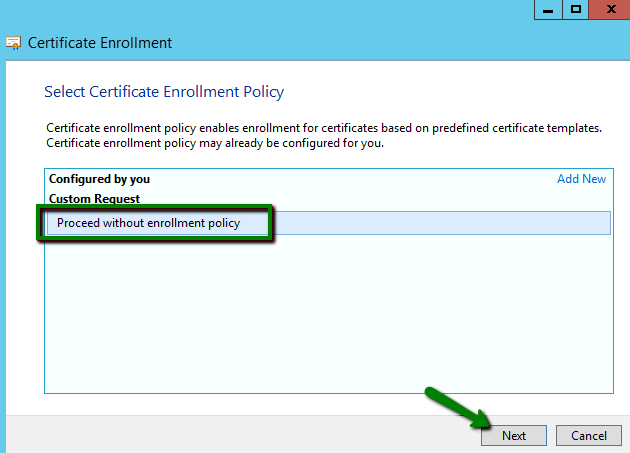
On the next screen, leave the pre-selected options (No template) CNG key and PKCS#10 and click Next:

Now we need to open the window, in which we will adjust the certificate request in the way that we can receive the certificate with the correct information and using the required key type. Click the drop-down arrow on the right and then the Properties button.
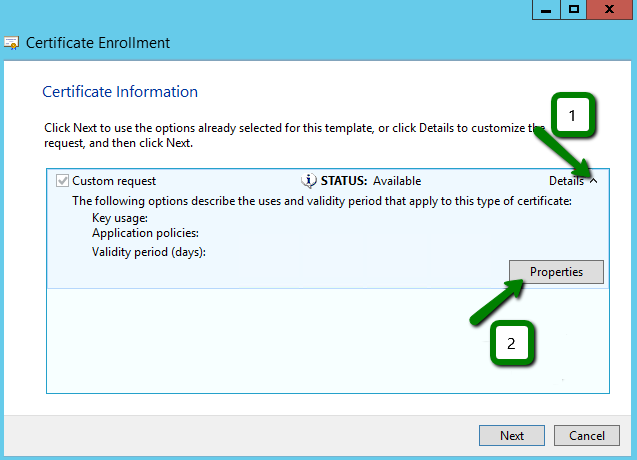
Add a friendly name value to the appropriate field so that you can identify this request entry in future. This field is used to give a name to the certificate, which can be the domain name the certificate will be issued for or virtually any other name:

On the next tab called Subject, we need to add a few fields to the request and specify their values. The most essential field types that must be present in the request are:
NOTE: If you need to add subject alternative names to the request, you can do it in the Alternative name section. Select the DNS field type and add the domain names one by one:
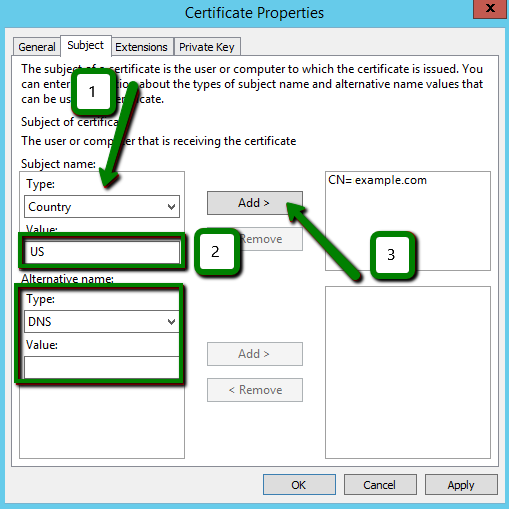
The result should look similar to this:
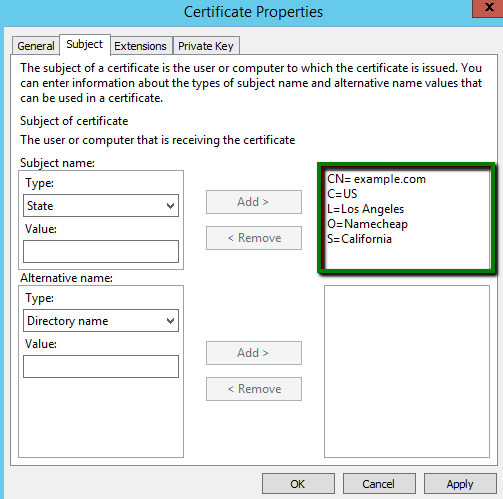
The last tab in this window we should open and review is the Private key. Let’s expand the Cryptographic Service Provider section and have a look. The default option here is the RSA algorithm, which is the industry standard today, although you can opt for "ECDSA" (if you need to issue an ECC certificate) by checking one of the entries on the picture below:
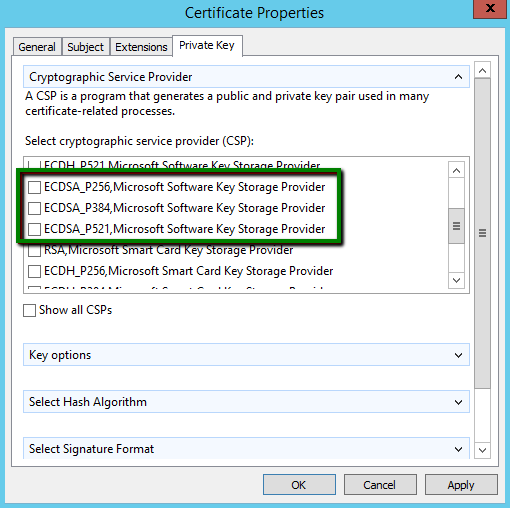
In the Key options section, if the RSA algorithm is used, make sure that Key size is set to at least 2048-bit.
NOTE: The certificates based on a key with the size less than 2048-bit are considered to be not secure, and the trusted Certificate Authorities do not issue them anymore.
If you plan to export the certificate, for example, for the installation on another instance, it is required to check the Make private key exportable option:

Now we can click Ok and move further.
The last screen of the Certificate Enrollment wizard requires us to specify the name of the file the CSR code will be saved into and its location in the file system. Also, make sure that File Format is set to Base64. Then click the Finish button to initiate the private key and CSR generation with the attributes we have set just now:
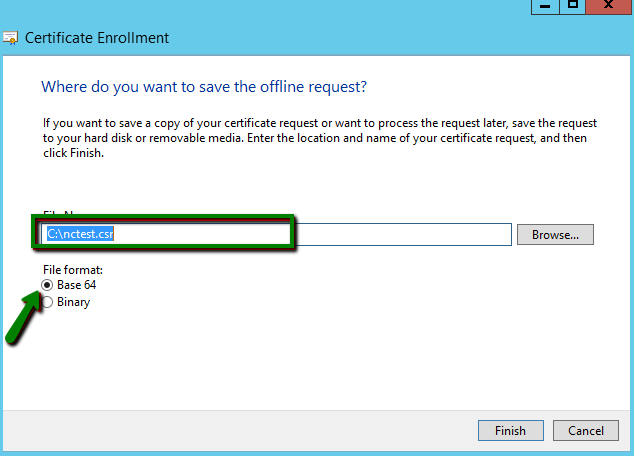
Certreq is the command line-based utility, which is used mostly for creating and submitting certificate requests and retrieving, accepting and installing responses from Certificate Authorities.
Before we begin working with “certreq”, we need to create a policy file from which the information required for the CSR will be pulled up. Create a new regular text file and open it. Then copy and paste the text from below into the file (select the piece of code either for RSA or ECDSA):
RSA
;----------------- request.inf -----------------
[Version]
Signature="$Windows NT$"
[NewRequest]
Subject = "C=US, O=Namecheap, CN=example.com, L=Los Angeles, S=California"
KeySpec = 1
KeyLength = 2048
Exportable = TRUE
MachineKeySet = TRUE
SMIME = False
PrivateKeyArchive = FALSE
UserProtected = FALSE
UseExistingKeySet = FALSE
ProviderName = "Microsoft RSA SChannel Cryptographic Provider"
ProviderType = 12
RequestType = PKCS10
KeyUsage = 0xa0
HashAlgorithm = SHA256
[EnhancedKeyUsageExtension]
OID=1.3.6.1.5.5.7.3.1
;-----------------------------------------------
ECDSA
;----------------- request.inf -----------------
[Version]
Signature="$Windows NT$"
[NewRequest]
Subject = "C=US, O=Namecheap, CN=example.com, L=Los Angeles, S=California"
KeyAlgorithm = ECDSA_P384 ; can be changed to 256 or 521
Exportable = TRUE
MachineKeySet = TRUE
SMIME = False
PrivateKeyArchive = FALSE
UserProtected = FALSE
UseExistingKeySet = FALSE
ProviderName = "Microsoft Software Key Storage Provider"
ProviderType = 12
RequestType = PKCS10
KeyUsage = 0xa0
HashAlgorithm = SHA256
[EnhancedKeyUsageExtension]
OID=1.3.6.1.5.5.7.3.1
;-----------------------------------------------
NOTE: You can add the street address value to the CSR code by specifying the Street variable in the Subject directive as follows:
Subject = " CN=example.com, C=US, O=Namecheap, L=Los Angeles, S=California , Street= Test Avenue 1"
Make sure that you change the values highlighted in black with the values that would be valid for your request. Then save the file as the .inf type (request.inf, for instance):
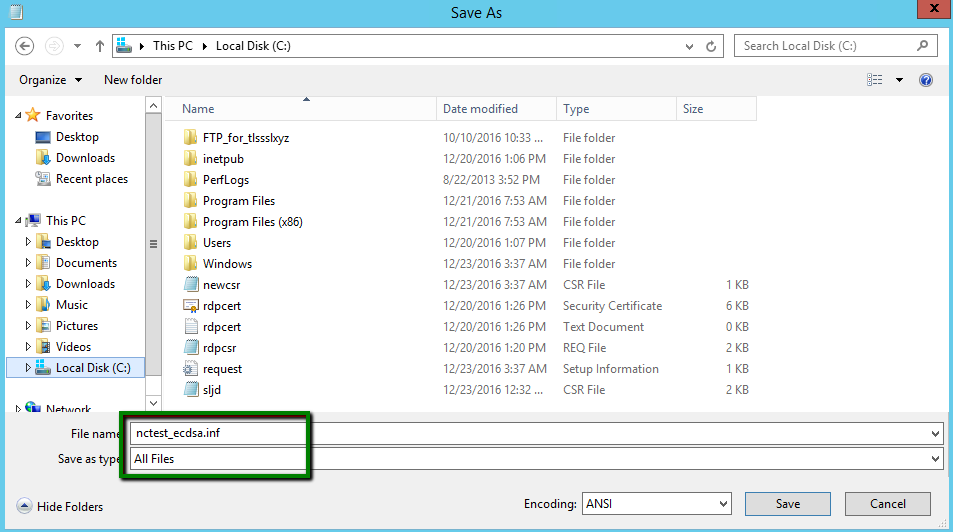
Now we can open the command line prompt: Win+R >> cmd >> Enter.
Navigate to the folder in which the policy file is saved using the “cd” command:
cd C:\
Run the following command to initiate the CSR generation:
certreq.exe -new request.inf nctest.csr

If the Request Created message appears in response to the command, the CSR code is created and saved into the .csr file (nctest_ecdsa.csr in the example above).
NOTE: When you are asked to provide the subject alternative names, you can either specify them if it is required or simply omit this step by pressing Enter.
Finally, the Powershell window will produce the summary of the provided information, hashing and key algorithm details and the CSR code, offering to copy the CSR to clipboard right away:
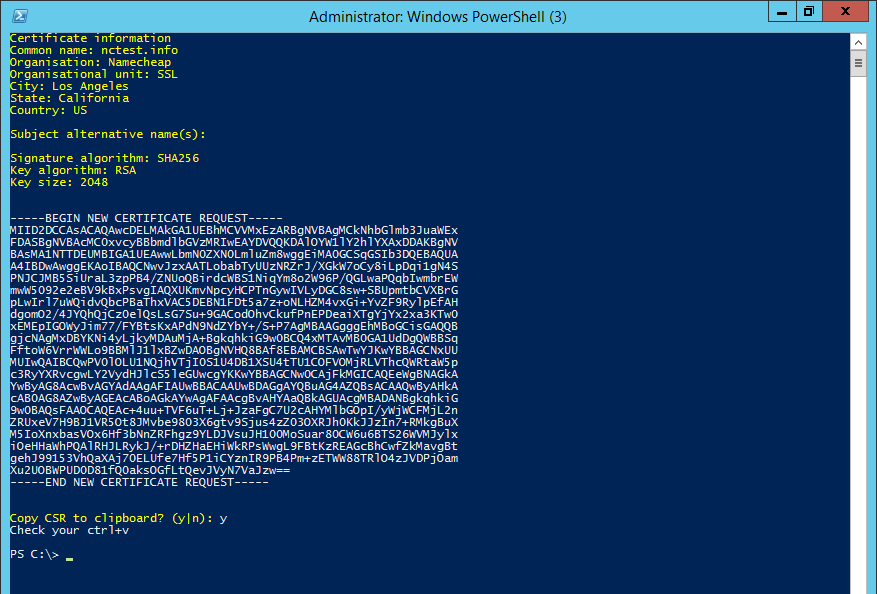
When the CSR code is generated using any of the methods described above, you can proceed with the SSL certificate activation.
{}Need help? We're always here for you.
{}